When cooking Chinese food, it can be difficult to make sense of all the sauces, condiments, and other ingredients involved in the recipes. With this growing list of Chinese sauces, wines, vinegars, and oils, we’re here to shed light on both essential ingredients and more obscure items you may come across at the Asian market.
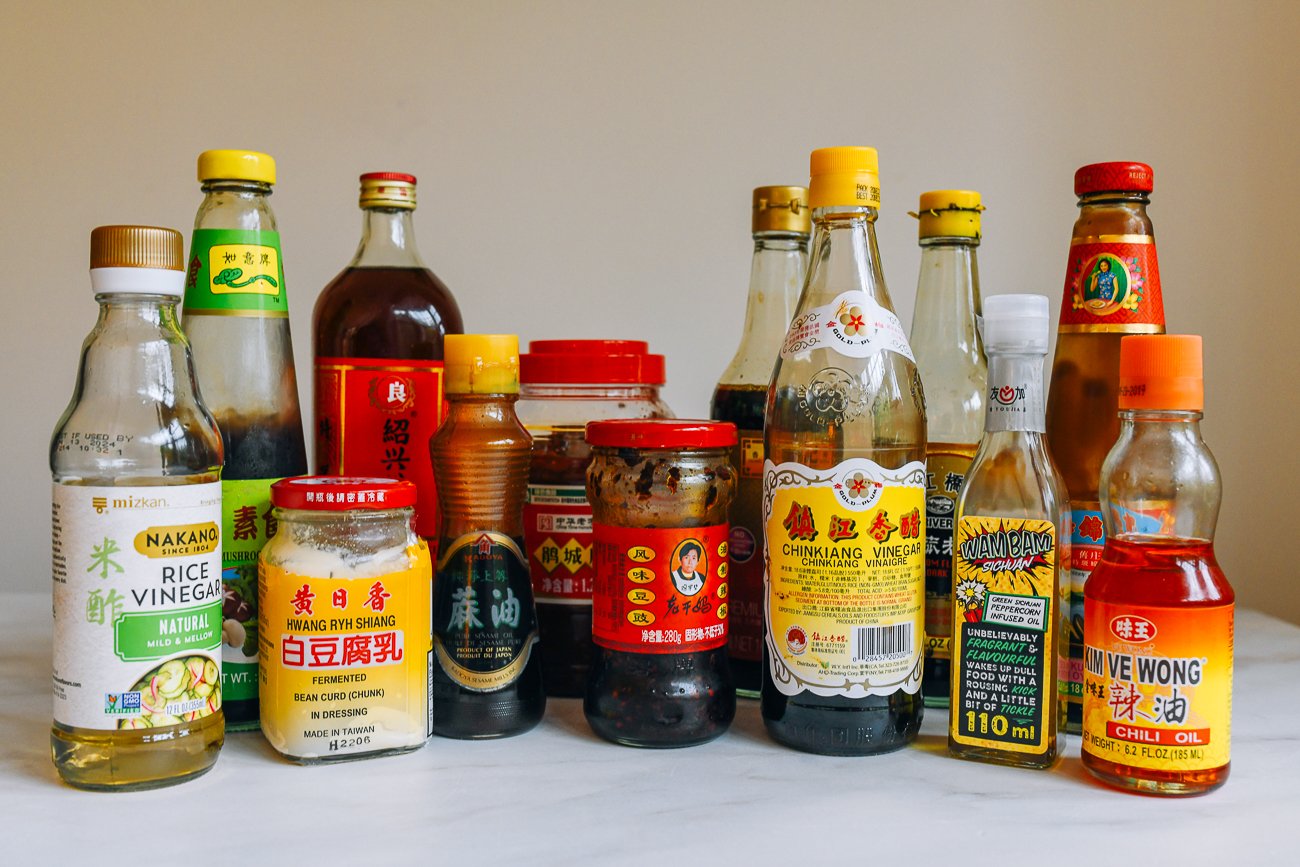
Many readers over the years have expressed feeling overwhelmed in the sauce aisle of the Chinese grocery store. We understand. You’re greeted with row after row of bottles, jars, and cans, some with odd English translations and labels that don’t explain how they should be used. But with a little knowledge, you can walk into that aisle with confidence!
Below, you’ll find a short description of each ingredient, as well as a link to a more in-depth article, if available. We recommend exploring those in-depth articles if you have time, as they discuss more about how the ingredient is used, how to store it, and brands we like.
Click on an ingredient below to jump to it!
CHINESE SAUCES:
Wines
Vinegars
Oils
Other
If you’re looking for a different kind of ingredient, be sure to check our main Chinese ingredients glossary main page, where you can easily locate what you’re looking for.
This is a living page that we continuously update, so if you have any suggestions, additions, or questions, feel free to comment below.
NOTE!
In general, these products can be found in any well-stocked Chinese grocery store. For those of you who can’t find local Chinese markets, we’ve included Amazon and other retail links to shop online. Full disclosure, these are affiliate links that allow us to make a small commission, but be aware that online vendors sometimes sell at premium prices and/or in bulk (you may have to buy 2 bottles or a larger size). It’s always best to shop at your local Chinese market if you have one!
Other online sources of ingredients include:
Some of the above sources are regional, and others ship nationwide. Some carry only dry goods, while others (usually the regional ones) also carry produce and refrigerated products.
OR:
Get our hand-picked pantry essentials in one place!
We worked with Pearl River Mart, a family-owned Manhattan Chinatown institution, in business since 1971, to collect our pantry essentials (and some extras!) all in one gift box! These are the ingredients we use in our own kitchen.
Get The Woks of Life x Pearl River Mart Pantry Essentials Friendship Box!
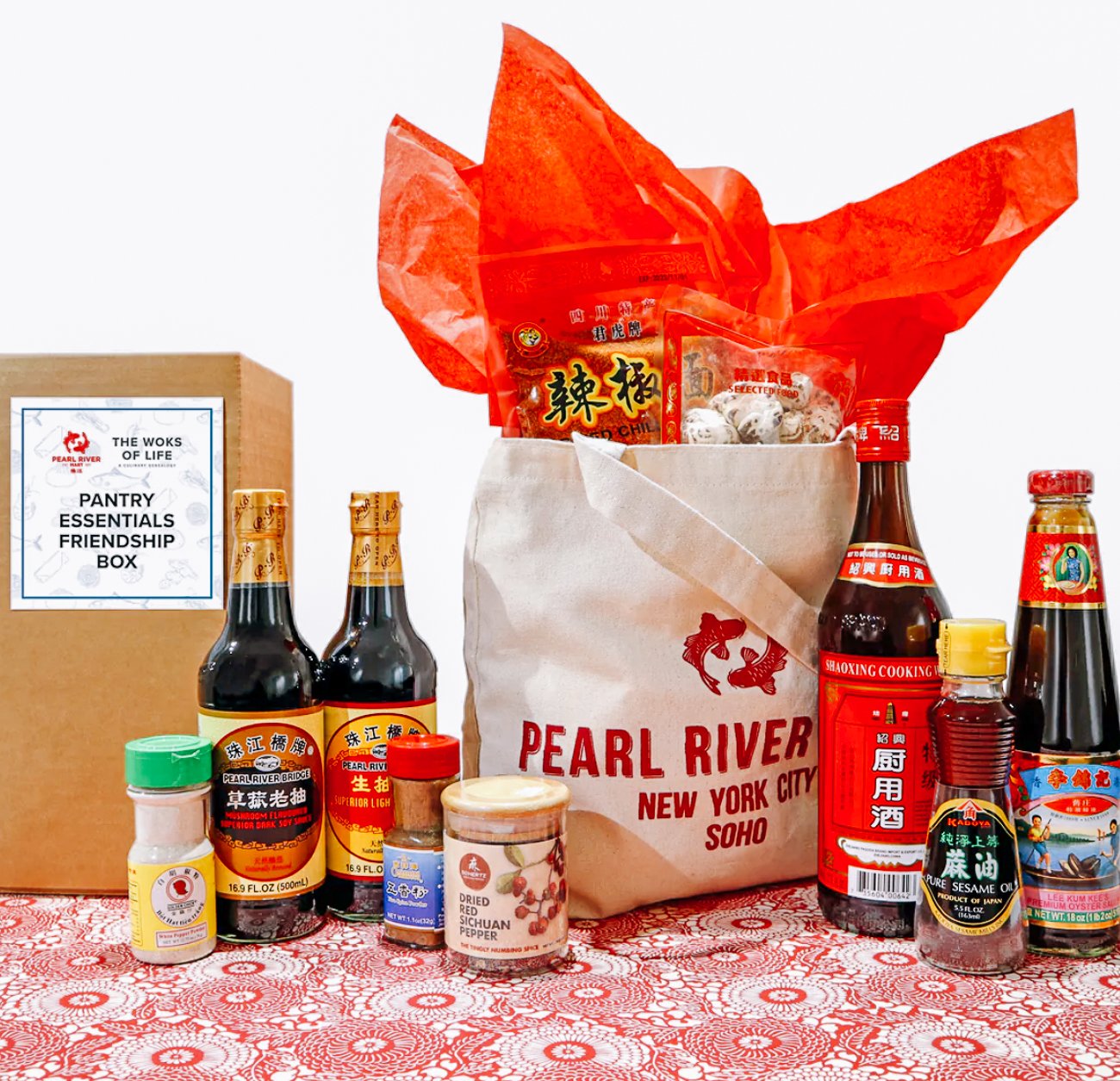
Get it shipped directly to you and start cooking! Or add a copy of our cookbook for a unique wedding/wedding shower, holiday, birthday, or anytime gift! If you want to beef up the gift basket even more, Pearl River Mart sells woks, wok spatulas, and a plethora of other Chinese kitchen equipment! Check out our Chinese cooking tools page for ideas.
Chinese Sauces
Soy Sauce (Regular/light) (酱油,Jiàngyóu)
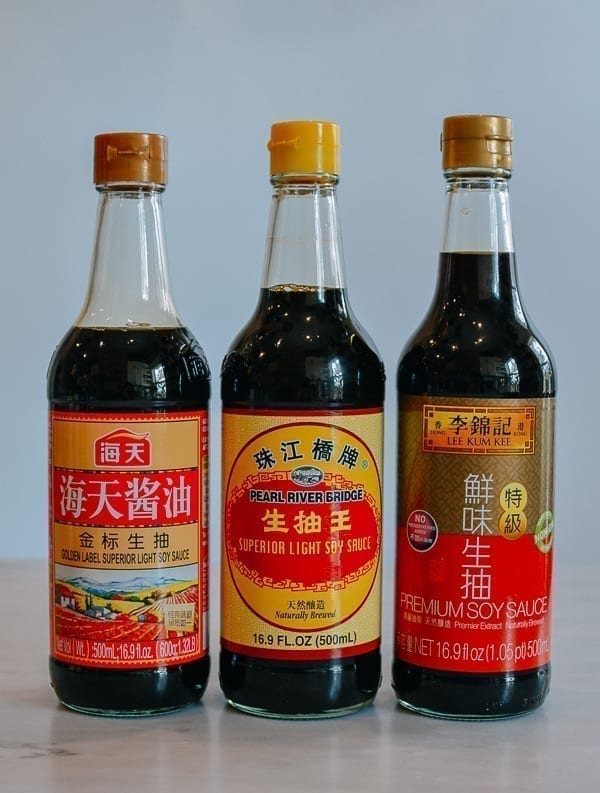
Soy sauce (jiàng yóu, 酱油), the most common of Chinese sauces, sounds simple, and for the most part, it is. However, there are many types, each unique to different Asian cuisines (Chinese, Japanese, Thai, etc.). When cooking a particular ethnic dish (say, Chinese), use the proper type–in this case, Chinese light soy sauce. Using a Japanese soy sauce in a Chinese dish will yield different flavors. Kikkoman, for instance, is a well-known Japanese brand, but we don’t use it for Chinese cooking.
So what is “light soy sauce?” Chinese Light soy sauce (shēng chōu, 生抽) is the most common soy sauce in Chinese cooking. If our recipes call for simply, “soy sauce,” this is what we are referring to.
The term “light” distinguishes it from Chinese dark soy sauce, which is thicker and darker in color. Generally, if it’s a Chinese brand of soy sauce, and it doesn’t say “dark” on the label, it’s light soy sauce. Common brands include Pearl River Bridge and Lee Kum Kee.
For more information about light soy sauce (including the brand we use), and various other types, see our detailed post on Everything You Need to Know About Soy Sauce.
Dark Soy Sauce (老抽, Lǎo chōu)
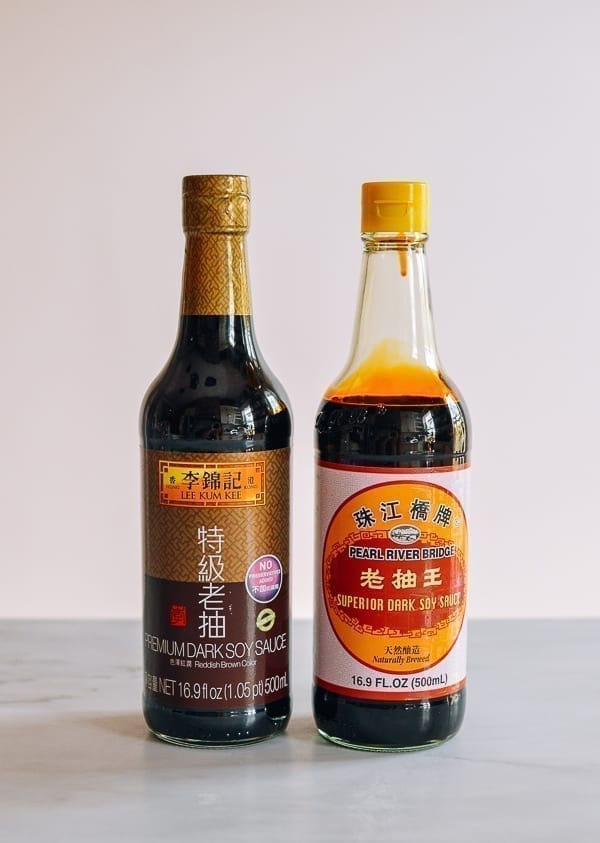
Dark soy sauce (lǎo chōu, 老抽) is just that: a thicker, darker version of soy sauce that is used for both flavor and color. Dark soy sauce is the go-to ingredient to darken the color in many Noodle and Fried Rice dishes, as well as sauces and stir-fries. It is also commonly used in marinades and braised/red-cooked (hong shao) dishes. As for brands, once again, we’ve got Lee Kum Kee and Pearl River Bridge. Read more about dark soy sauce, including a possible substitution using regular soy sauce and molasses.
mushroom-flavored Dark soy (蘑菇老抽, MÓGŪ LǍO CHŌU)
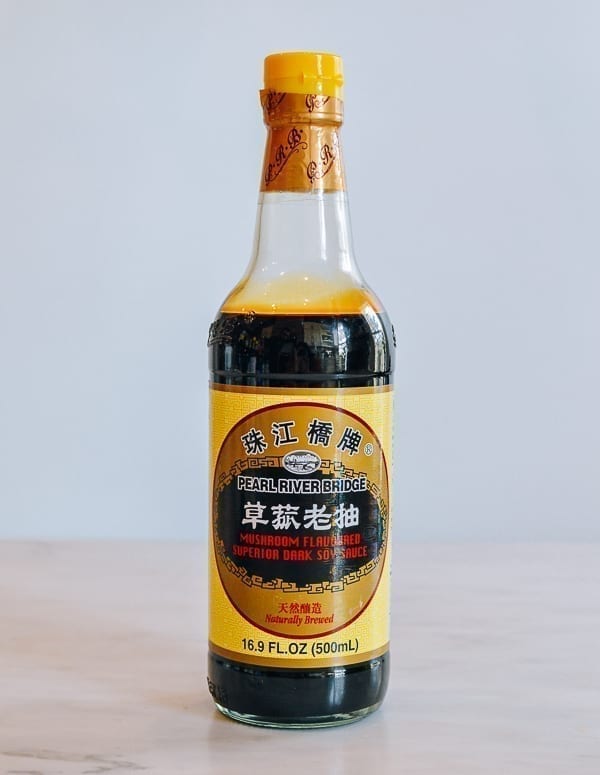
Dark soy sauces also come in a mushroom flavor (mó gū lǎo chōu, 蘑菇老抽), which adds a higher level of naturally occurring glutamate (the source of umami, the savory fifth taste) to your dish. We favor mushroom dark soy over plain dark soy sauce (why not add more flavor to any dish if you have the option?), but if you can’t or don’t like to eat mushrooms, just go for the tried and true dark soy sauce. The two can be used interchangeably anytime dark soy sauce is called for.
Double black soy sauce (雙老頭抽, SHUĀNG LǍOTÓU CHŌU)
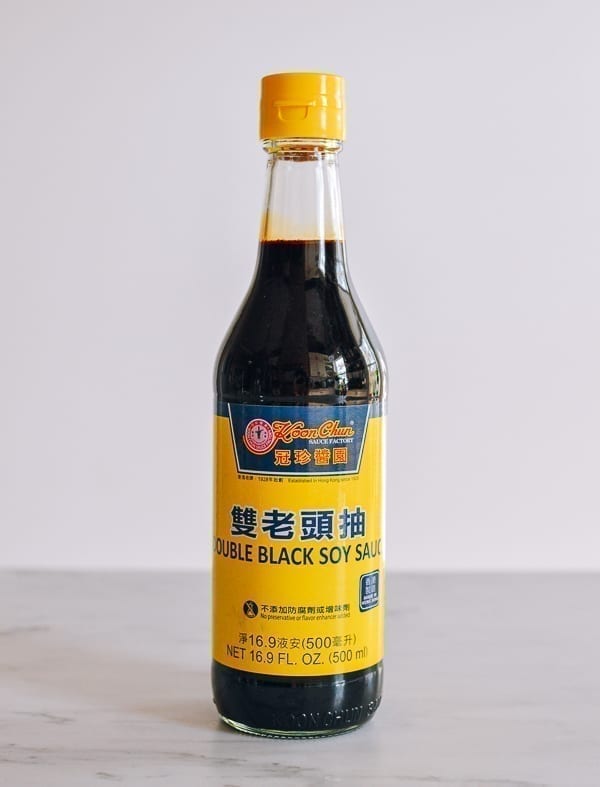
Pronounced in Cantonese as, “sheung lo tao cho,” double black soy is a super dark soy sauce with added molasses. Some chefs like it for applications where a darker, richer color and some sweetness is needed. I’ve heard varying opinions about using double black soy with the additional molasses. Some say the flavor is “off,” and others say that for the right dish, it’s a great addition. The most widely available brand in the U.S. is Koon Chun double black soy.
Seasoned Soy Sauce (蒸鱼豉油, ZHĒNG YÚ CHǏ YÓU)
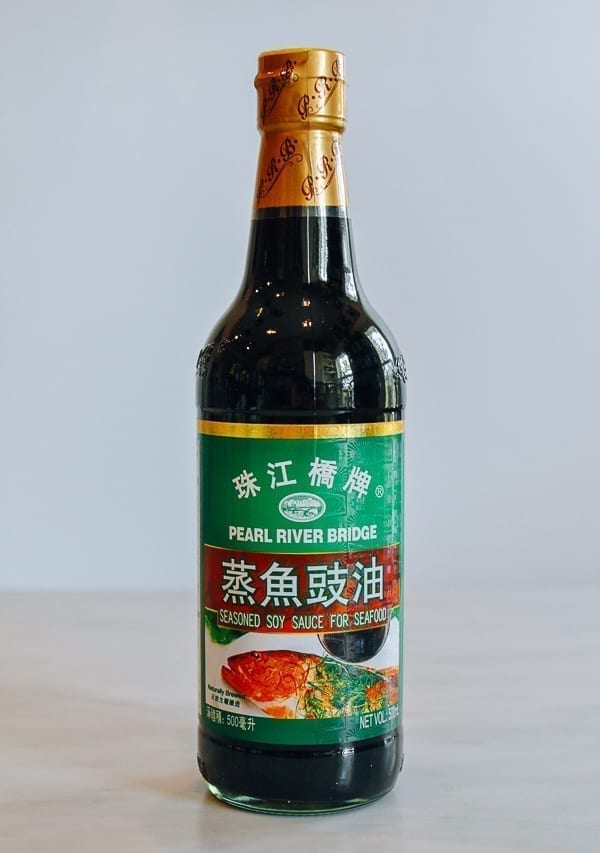
Seasoned soy sauce is a light soy sauce (i.e. a “regular” soy sauce) with seasonings added, usually for use in seafood dishes. In our recipes, we generally use light soy sauce and add sugar plus other seasonings rather than bottled seasoned soy sauce. That said, some like to keep seasoned soy sauce in the pantry because it’s convenient and quick. Some also have MSG for a little extra kick of savoriness. Most major soy sauce brands make a version, usually labeled “seasoned soy sauce for seafood.”
Japanese Soy Sauce (Kikkoman)
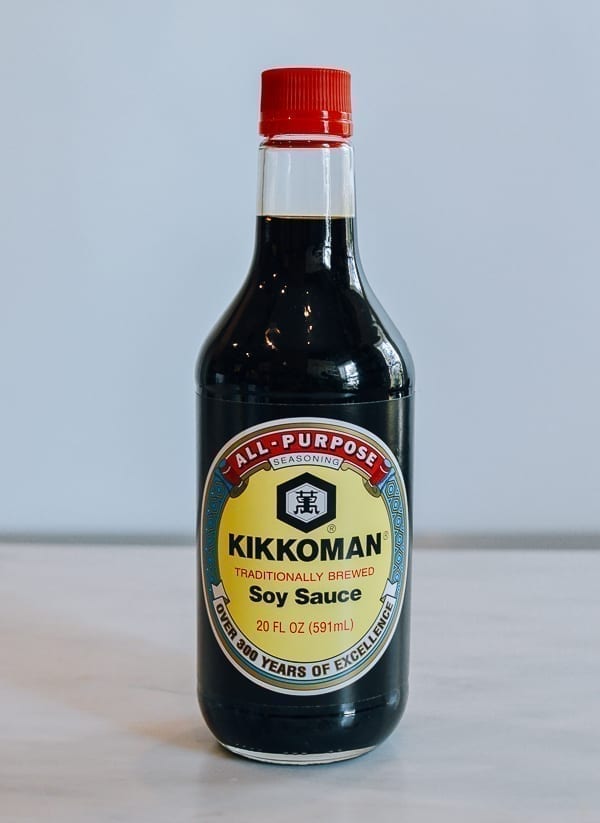
While there are many Japanese soy sauces available these days, Kikkoman is probably the best-known soy sauce brand among American consumers and will be available at your supermarket 9 times out of 10. This is why we’ve singled it out here! If you can’t find anything else, it is generally fine to use in place of Chinese light soy sauce, but it will yield a different taste. Kikkoman used to be the only soy sauce you saw in grocery stores, but, luckily, times have changed!
Thai Soy Sauce
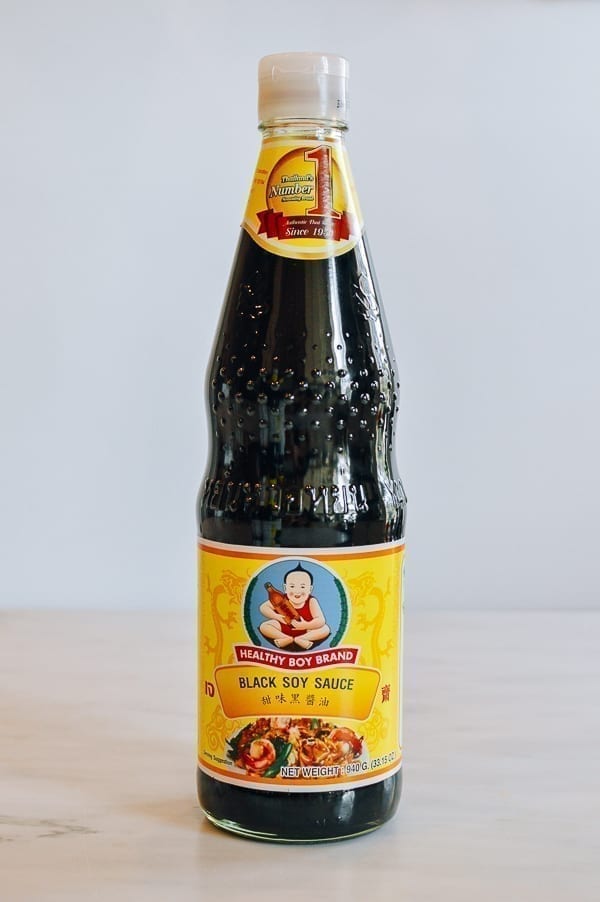
There are three main types of Thai soy sauce: thin soy sauce, black soy sauce, and sweet soy sauce. Thai thin soy sauce is the most often used, and similar to Chinese light soy sauce, though a bit thinner and lighter in color. Black soy sauce is similar to dark soy sauce, and sweet soy sauce is extremely sweet—downright syrupy! We only use these soy sauces in Thai recipes. Read more about these ingredients in our Thai Soy Sauce article. The most commonly available brand is Healthy Boy Soy Sauce.
Low Sodium Soy Sauce
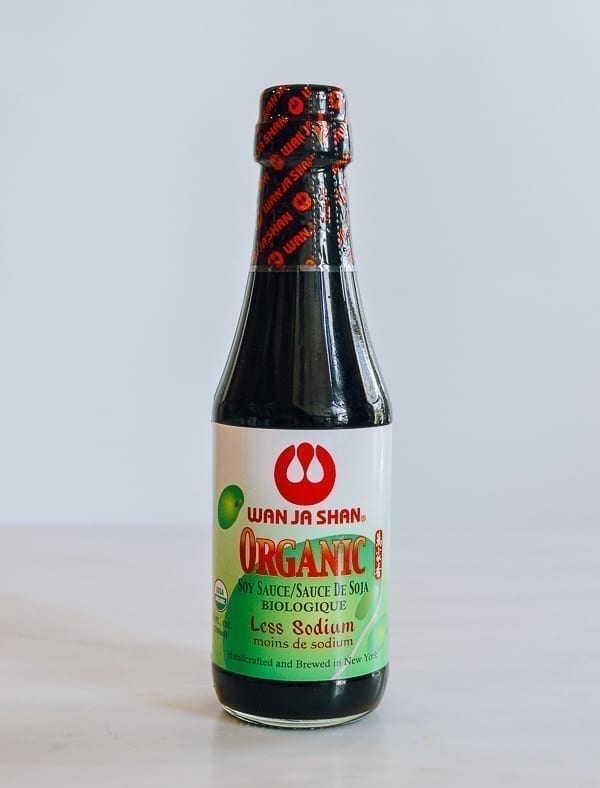
Low sodium soy sauces are now more common, as producers meet consumer demand. If cooking Chinese recipes, look for a low sodium soy sauce from a Chinese brand. We’ve seen Lee Kum Kee Low Sodium Soy Sauce appear in Chinese markets. If you’re watching your sodium intake, you may prefer to use a low sodium soy sauce whenever light or regular soy sauce is called for. You can also use it in recipes that use a lot of soy sauce, like our Mongolian Beef and our Chicken Adobo!
Gluten-free Soy Sauce
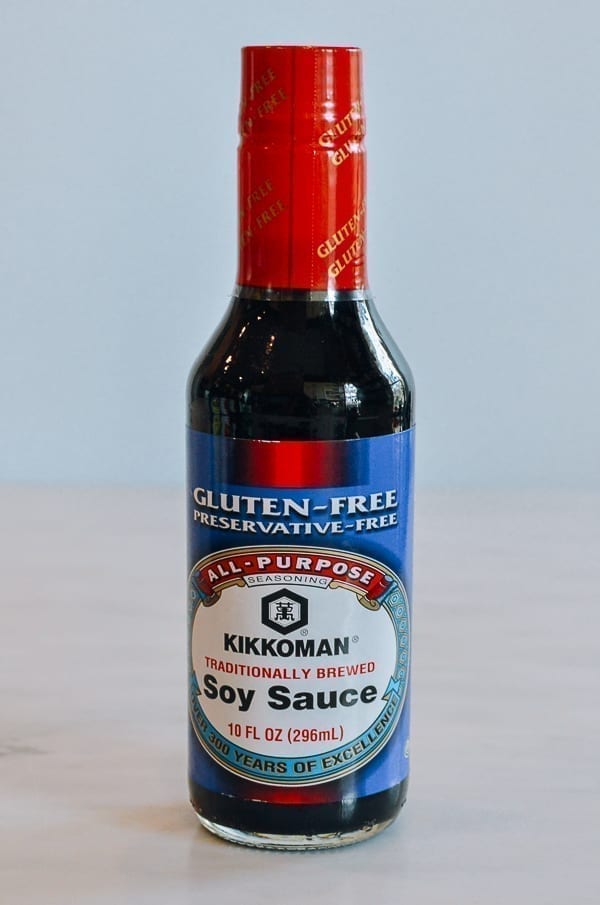
Many of our readers have asked for gluten-free recipes, and we have done our best to develop and also point out our naturally gluten-free (or gluten-free adaptable) recipes for those folks who have a gluten sensitivity or Celiac’s disease. While most soy sauces contain a small amount of wheat for fermentation, there are several gluten-free soy sauces on the market, including of course Kikkoman Gluten-free Soy Sauce, as well as a Chinese Gluten-free Soy Sauce from Lee Kum Kee. These can also be used to make our dark soy sauce substitution.
Tamari
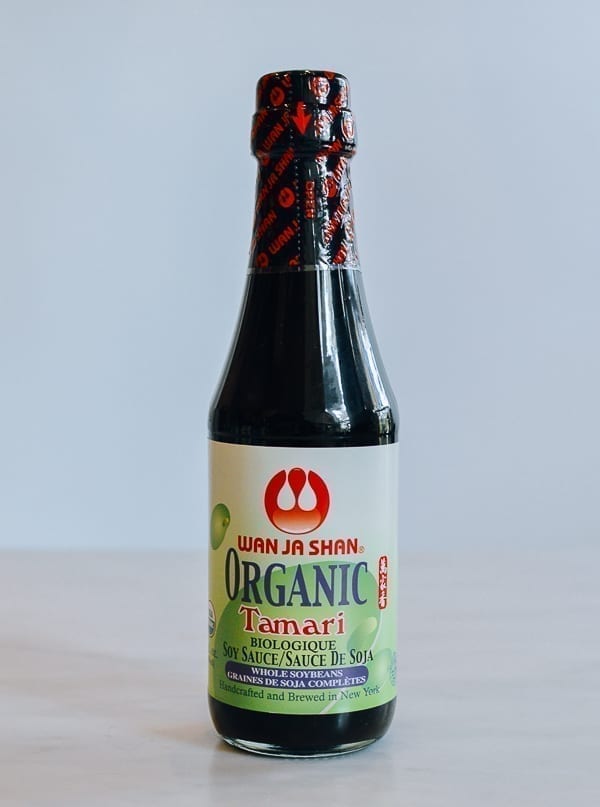
Tamari is a Japanese condiment similar to soy sauce, in that it is made from fermented soybeans. Tamari, however, does not usually have wheat in it (it originated as a by-product of miso production), which is why it is often billed as a gluten-free alternative to soy sauce (make sure it is actually labeled “gluten-free”). It does have its own distinctive flavor, however, and some say it’s more complex. If looking for a gluten-free alternative to soy sauce, we suggest buying a gluten-free soy sauce rather than Tamari.
Oyster Sauce (蚝油, Háoyóu)
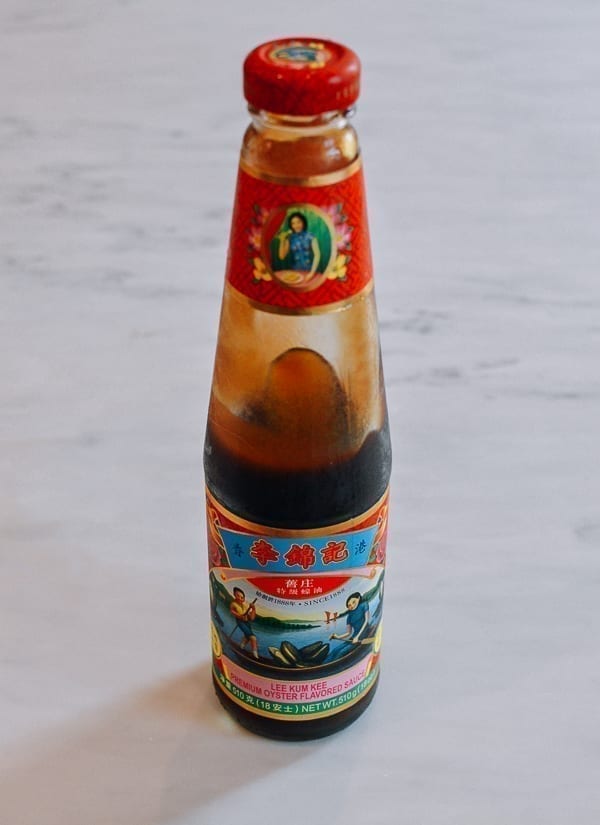
Oyster sauce is a savory seasoning made with oyster extracts. It doesn’t taste strongly of oysters, but it does pack a huge hit of umami. I (Bill) remember my father saying, “If you want to make any dish taste better, just add oyster sauce.” He was right, so use this best of Chinese sauces when you’re looking for a simple flavor boost. We use it in sauces, marinades, and braises. Look for Lee Kum Kee Premium Oyster Sauce (The company’s founder invented the stuff.) They also make a gluten-free oyster sauce.
Vegetarian oyster sauce (素食蚝油, Sùshí háoyóu)
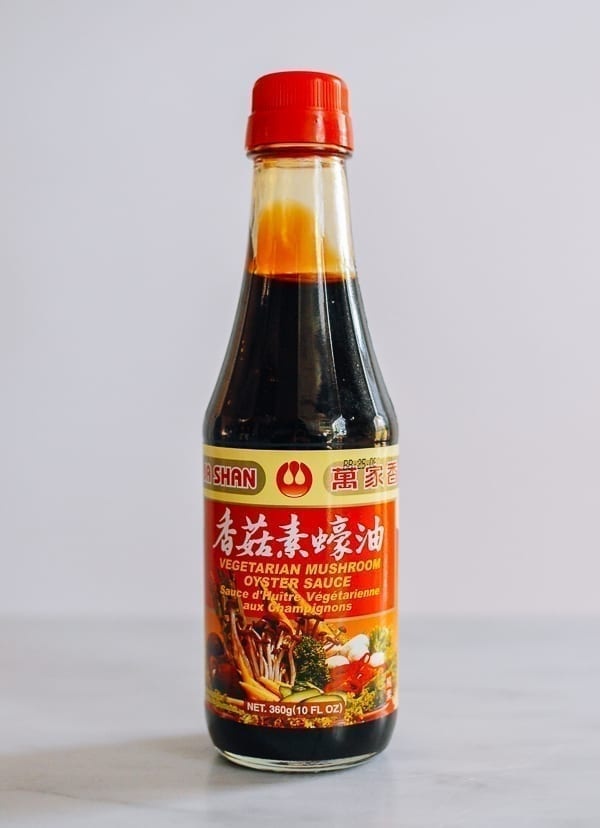
If you’re vegan, vegetarian, or allergic to shellfish, there is an alternative to oyster sauce, known as vegetarian oyster sauce, or sometimes “vegetarian mushroom oyster sauce,” or “vegetarian stir-fry sauce.” They are made with mushrooms rather than oysters. It’s not quite as easy to find as regular oyster sauce, but various brands do make a version, including Wan Ja Shan (pictured to the left) and Lee Kum Kee’s Vegetarian Stir-fry Sauce. Read more about it in our full Vegetarian Oyster Sauce article.
Fish Sauce (鱼露, yú lù)
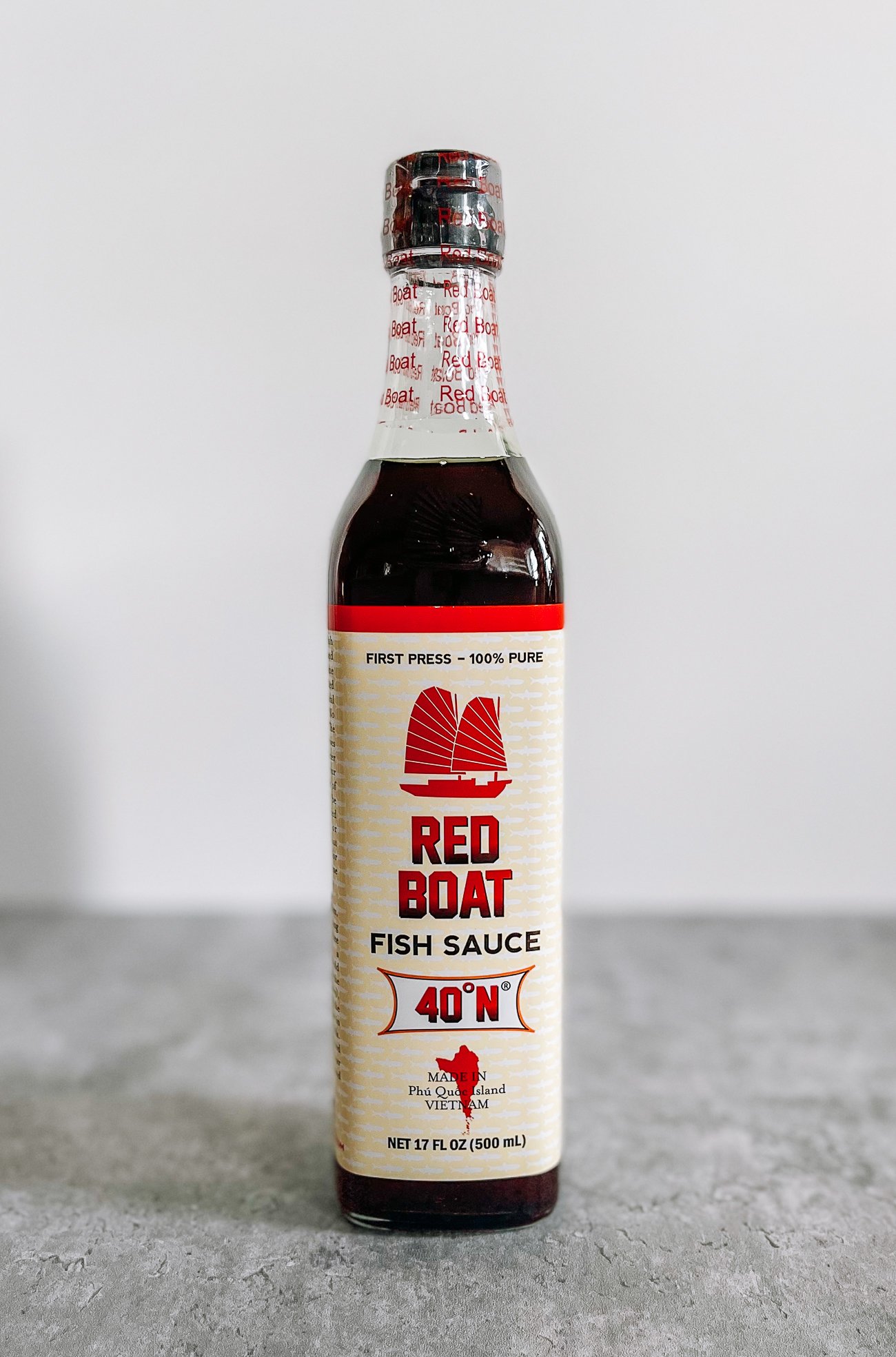
Fish sauce is a liquid condiment or seasoning made from fermenting fish or krill. It’s a bit like anchovies on pizza—you either love it or hate it. Fish sauce is used in many Chinese dishes, but is even more of an essential ingredient in Southeast Asian countries like Thailand, Vietnam, and Malaysia. We love using it in our cooking. A touch of fish sauce in your eggplant with garlic sauce or Thai basil beef will elevate all flavors present. It’s quite salty, so use a light hand. Red Boat Fish Sauce is a great option, and it’s gluten-free.
Vegan Fish Sauce
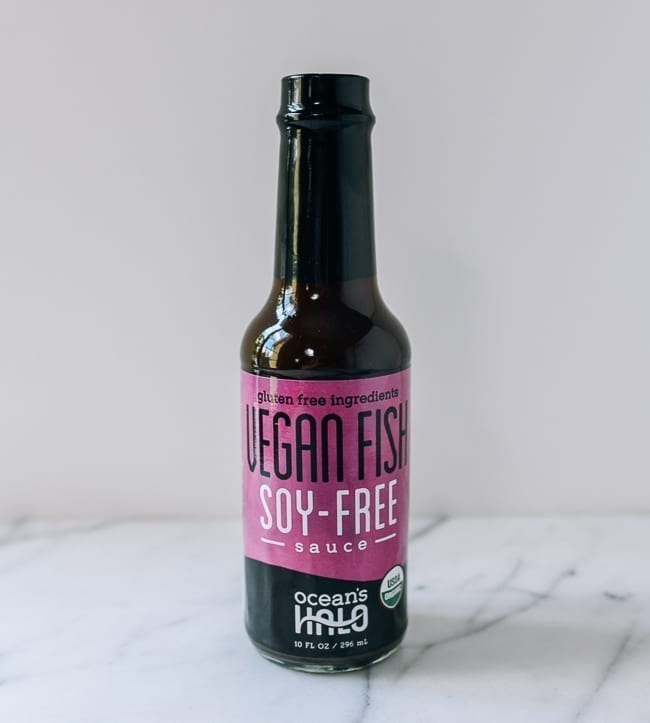
If have a seafood allergy or other dietary restriction, you can try vegan fish sauce as a substitute for fish sauce. We haven’t cooked much with it, but it’s a viable option if you’re cooking up Southeast Asian recipes and need an alternative to fish sauce. There are a few brands of vegan fish sauce on the market, flavored with ingredients like kelp and mushroom.
Shrimp Paste/Sauce, Belacan (虾酱, xiā jiàng)
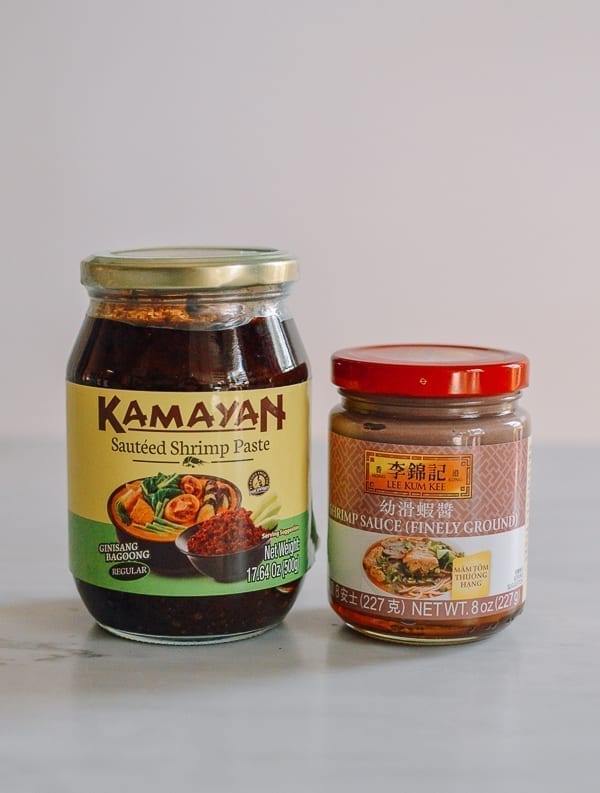
Shrimp paste or shrimp sauce is made from crushed or ground shrimp fermented with salt. Many Cantonese dishes, like stewed eggplant and tofu, use this pungent ingredient. The shrimp sauce we use comes in a jar and does have a sauce-like consistency, but it also comes in semi-dried rectangular blocks (the Malaysian version called belacan). You’ll find different versions of shrimp paste or shrimp sauce throughout southeast Asia, where it is used extensively.
Shacha Sauce (Chinese bbq sauce) (沙茶酱, shāchá jiàng)
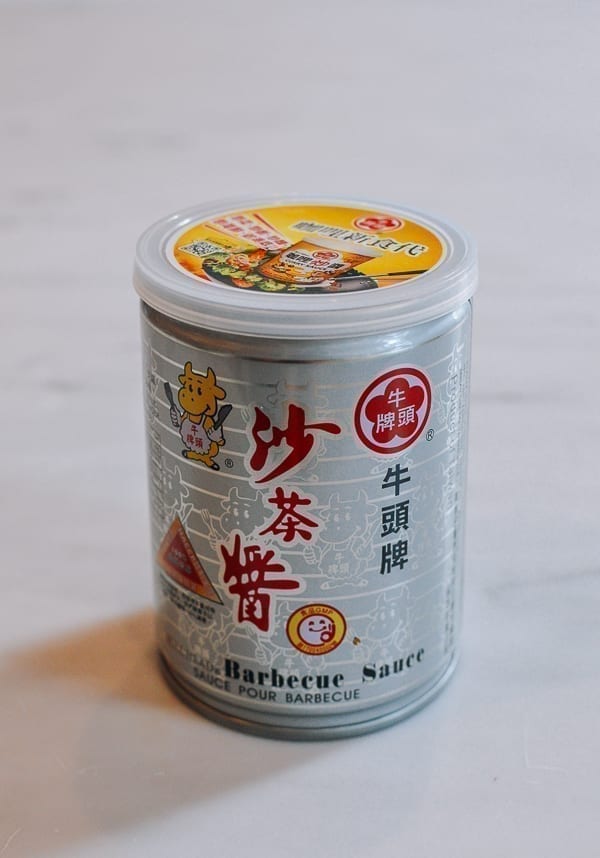
Shacha sauce is frequently used for barbecued meat, hence its common translation as “barbecue sauce,” but we use it mostly for hot pot dipping sauces and stir-fries. Made with garlic, shallots, chilies, and dried shrimp, it is quite tasty, with a seafood-y edge. It’s also a little spicy. Bullhead is the most widely available and popular brand we have seen and also comes in a spicy version. Try our Sha Cha Chicken or Sha Cha Beef, both of which use this Sacha sauce as the primary seasoning.
XO Sauce (XO酱, xO jiàng)
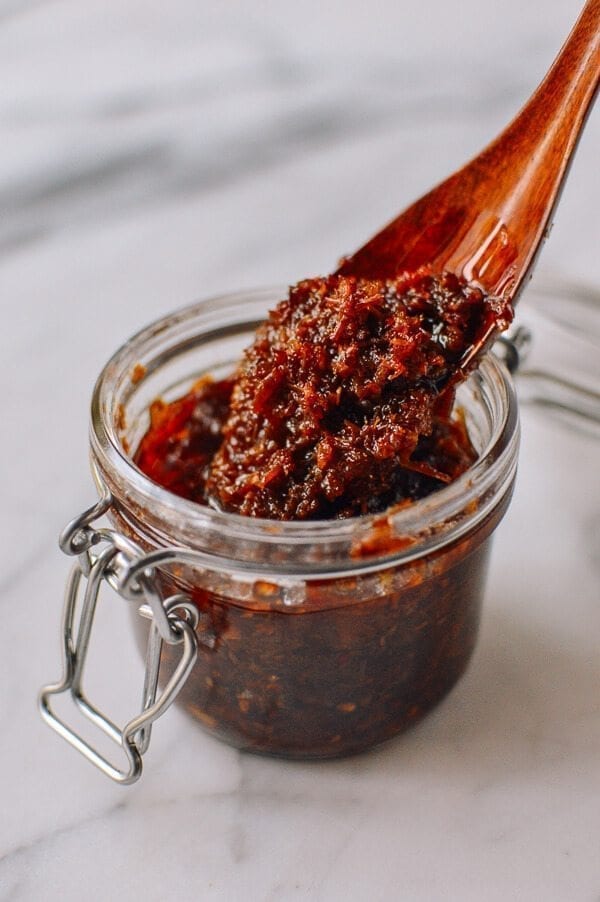
XO Sauce is a luxurious condiment that hails from Hong Kong, invented in the 1980s. The term “XO” in Hong Kong denotes luxury and prestige. Indeed, XO sauce is made with several very expensive ingredients, including dried scallops, dried shrimp, and Chinese cured ham. Prices vary depending on the quality of ingredients—always check the ingredients label before buying any jar of XO sauce. You can also make our from-scratch XO sauce, which is great over rice or noodles, or added to stir-fries. It also makes a wonderful gift!
Hoisin Sauce (海鲜酱, Hǎixiān jiàng)
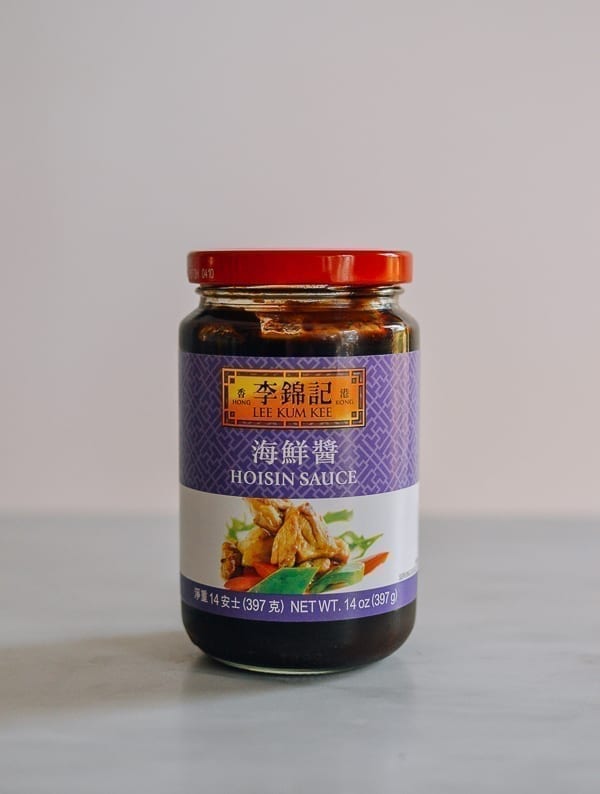
Hoisin sauce is the most well-known of the many Chinese fermented bean pastes. Often confused with sweet bean sauce (tián miàn jiàng, 甜面酱) and sweet bean paste (dòubàn jiàng, 豆瓣酱), it’s similar to those ingredients, but has its own flavor from added garlic, chili, and sesame. We use it in marinades and sauces for BBQ meat and for Peking duck here in the U.S. (In China, they use sweet bean sauce, see below.) Find hoisin sauce online, at the Chinese market, and in some mainstream supermarkets.
Sweet Bean Sauce/Sweet Flour Sauce (甜面酱, Tiánmiànjiàng)
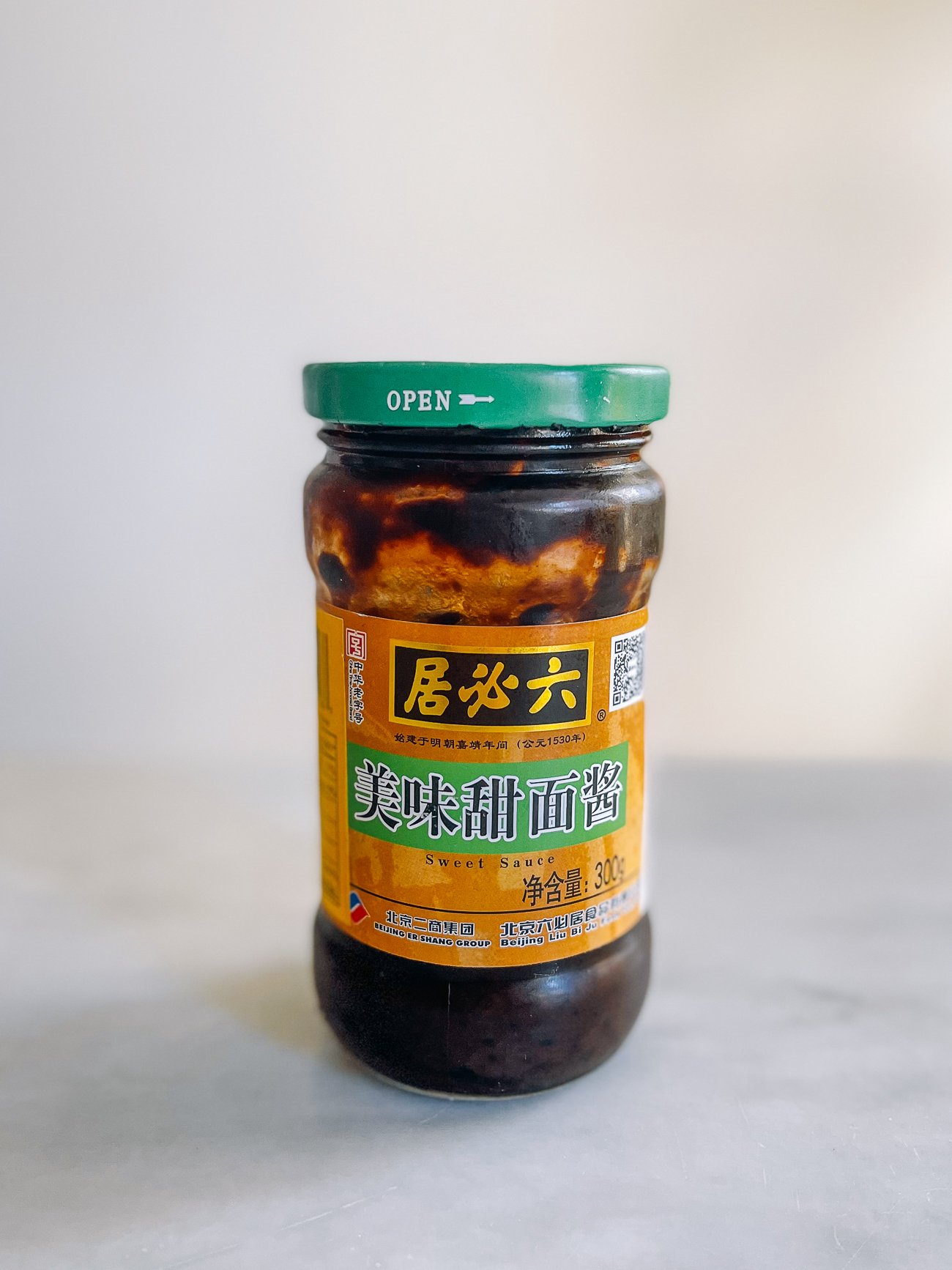
Sweet bean sauce (tián miàn jiàng, 甜面酱) is confusingly named, as its primary ingredient is not fermented soybeans, but fermented wheat flour. You may also sometimes see it labeled “sweet flour sauce” or “sweet flour paste.” Just look for the Chinese characters on the bottle, can, or tub. It is sweet and similar to hoisin sauce, so the two can largely be used interchangeably. This ingredient is used in northern Chinese regional cuisine, including recipes like Beijing Zha Jiang Mian and Peking Duck.
Chee Hou Sauce/Chuhou Sauce (柱侯酱, Zhù Hóu Jiàng)
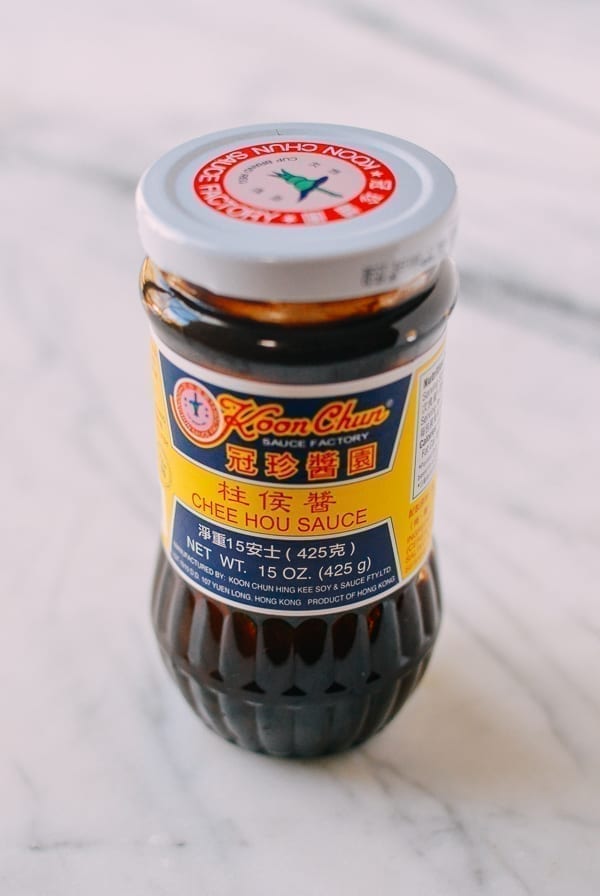
Chee Hou Sauce, sometimes called Chu Hou paste, is a fermented soybean sauce similar to Hoisin with a different mix of seasonings, including salted plums, salted lemons and fermented bean curd (though ingredients vary by brand). It is quite sweet and salty, and is used primarily in Cantonese-style braised dishes. The main brands you can find are Koon Chun, Lee Kum Kee, and Pearl River Bridge. If you have the luxury of choice, we prefer Koon Chun Chee Hou Sauce. If you can’t find this ingredient, substitute hoisin sauce.
Sweet Bean Paste (豆瓣酱, Dòubàn jiàng)
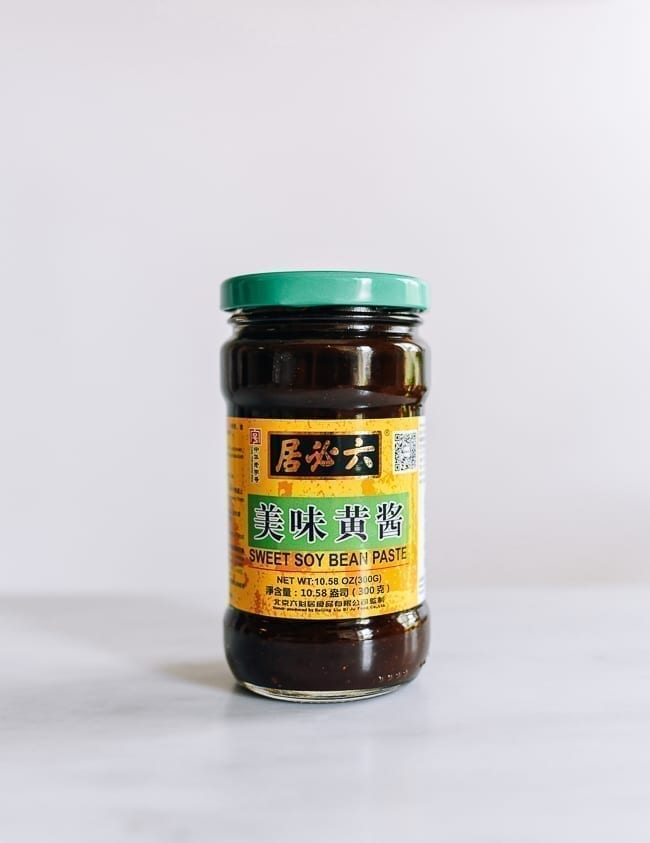
Sweet Bean Paste, or dòubàn jiàng (豆瓣酱), is another fermented soybean paste, not to be confused with spicy bean paste, known as là dòubàn jiàng (辣豆瓣酱), which is a Sichuan fermented broad bean sauce. It’s similar in taste, color, and texture to sweet bean sauce (tián miàn jiàng, 甜面酱), which is made primarily from wheat flour rather than soybeans. We rarely use this ingredient, though if you accidentally purchased it instead of sweet bean sauce, the two are generally interchangeable.
Ground Bean Sauce (磨原豉, Mó yuán shì)
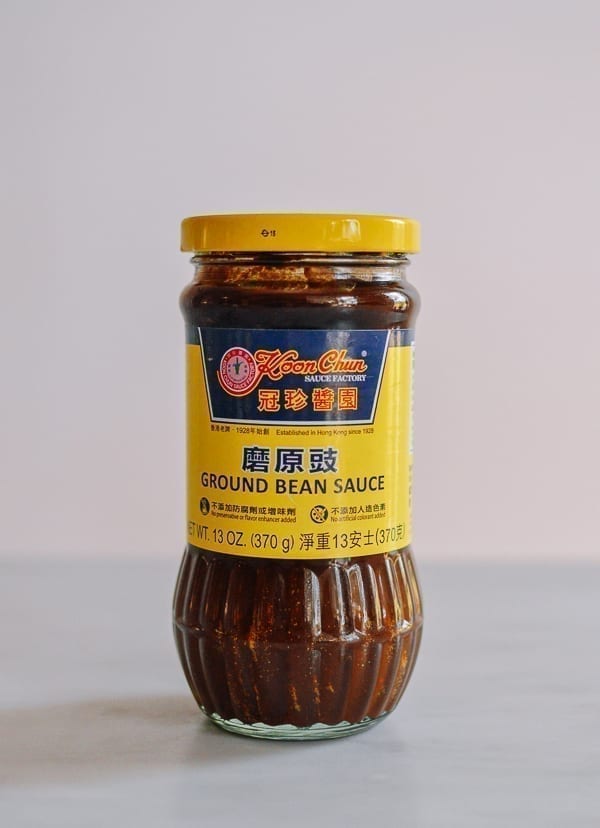
Ground bean sauce is a key Cantonese ingredient for marinades, stir-fries, braises, and sauces. In Cantonese, we call it, “meen see jeung,” and use it in stewed dishes and Chinese BBQ recipes like our Takeout-style Chinese Spare Ribs. Made with fermented yellow soy beans and spices, it’s less sweet than hoisin. We prefer Koon Chun ground bean sauce. You may see a similar jar labeled, “bean sauce,” without the spices. You can use either, but if given the choice, get the “ground bean sauce.”
Black Bean Garlic Sauce (蒜蓉豆豉酱, Suàn róng dòuchǐ jiàng)
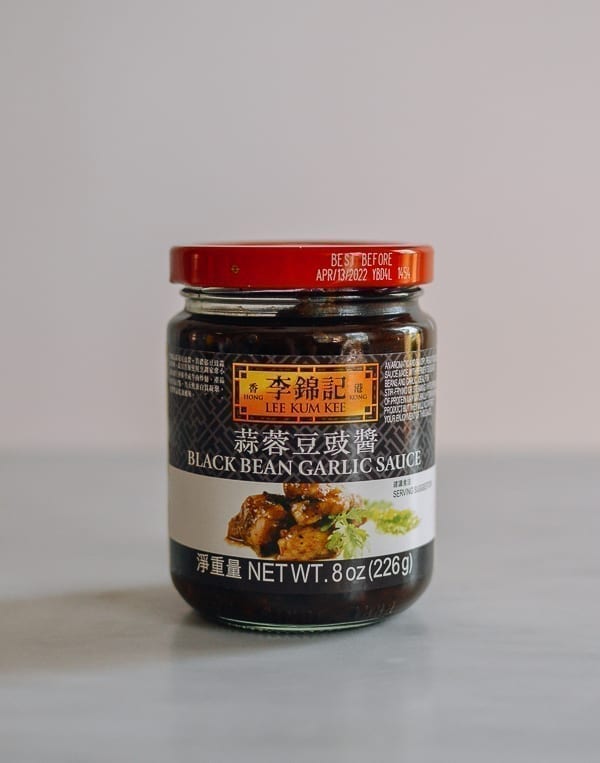
This is a pre-made sauce for black bean sauce dishes. Typically, we prefer using whole fermented black beans (see below), but this is a convenient jarred stir-fry sauce, especially if you have trouble locating whole fermented black beans. While black bean garlic sauce is convenient, it generally produces darker, murkier sauces, because the black beans are finely ground. If you want your sauces to look cleaner, use whole black beans. Try it in our Beef with Black Bean Sauce recipe.
Fermented black Beans (豆豉, Dòuchǐ)
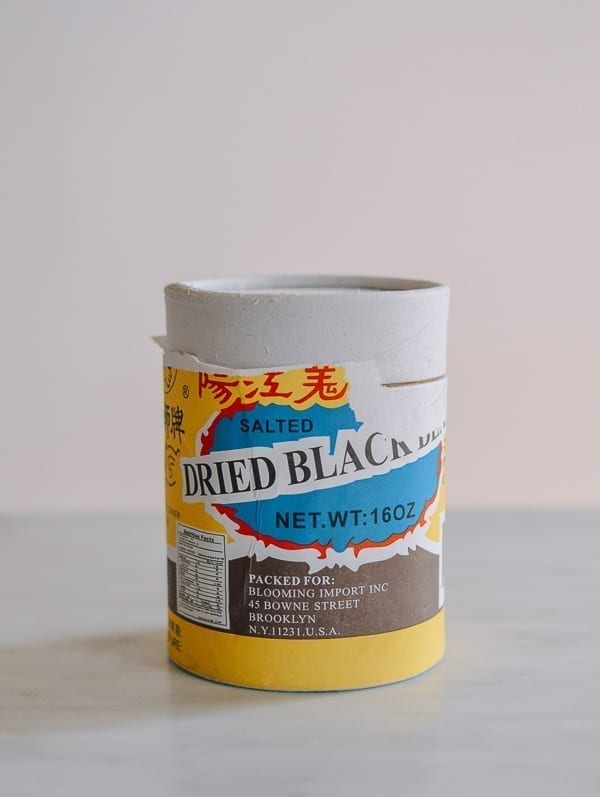
Fermented black beans, or dòu chǐ in Mandarin and dau see in Cantonese, are fermented black soybeans with salt and spices. Before use, you can rinse them in water to remove excess salt, though this is an optional step. They’ll keep forever in an airtight container in your fridge. You may find brands that have ginger as added flavoring, though we prefer the plain version. Find them in these cardboard canisters (left) or clear plastic bags. They’re quite inexpensive if you can get them at your local Chinese grocery!
Spicy Bean Sauce (辣豆瓣酱, Là dòubàn jiàng)
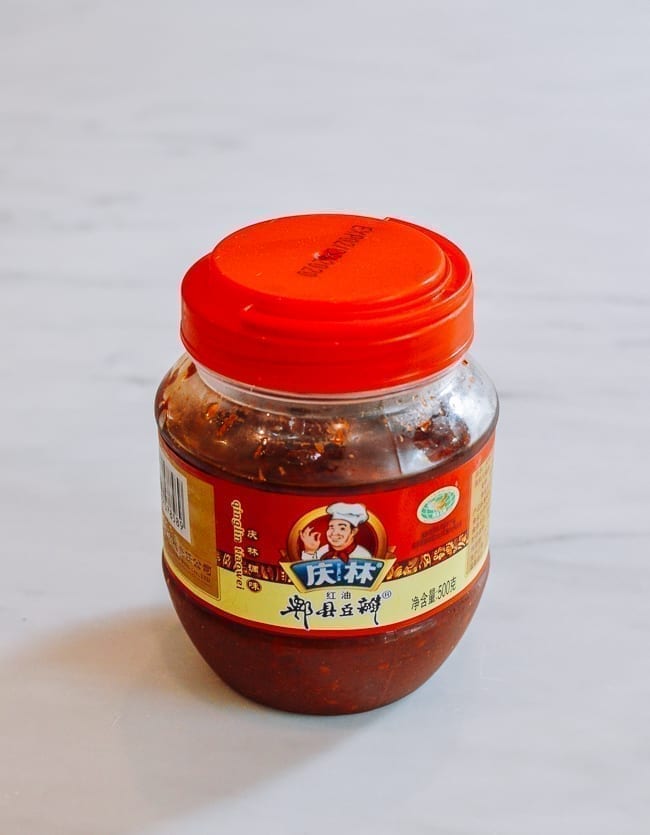
Spicy Bean Sauce, made with chilies and fermented broad beans, is a chunky, savory, spicy, and salty sauce used in many Sichuan dishes. Píxiàn dòubàn (郫縣豆瓣) is particularly well-known, named after the town of Pixian in Sichuan Province. Look for one made in this region. The Mala Market is a great resource for premium Sichuan ingredients. They offer a Pixian Doubanjiang sourced and packaged for them in Sichuan and a super premium 3-year aged Pixian Doubanjiang.
Chili Garlic Sauce

Made with chili pepper, garlic, rice vinegar, and salt, this sauce is spicy and fragrant with a flavor similar to Sriracha. It will keep in the fridge for months alongside your mayonnaise and ketchup. We use it as a dipping sauce for dim sum and dumplings and to accompany dishes like Chicken Pan Fried Noodles, but it’s also great for cooking, like in our Chili Garlic Shrimp recipe. Huy Fong is the most common brand.
Duo Jiao Sauce / Chopped Chili (剁椒, Duò jiāo)
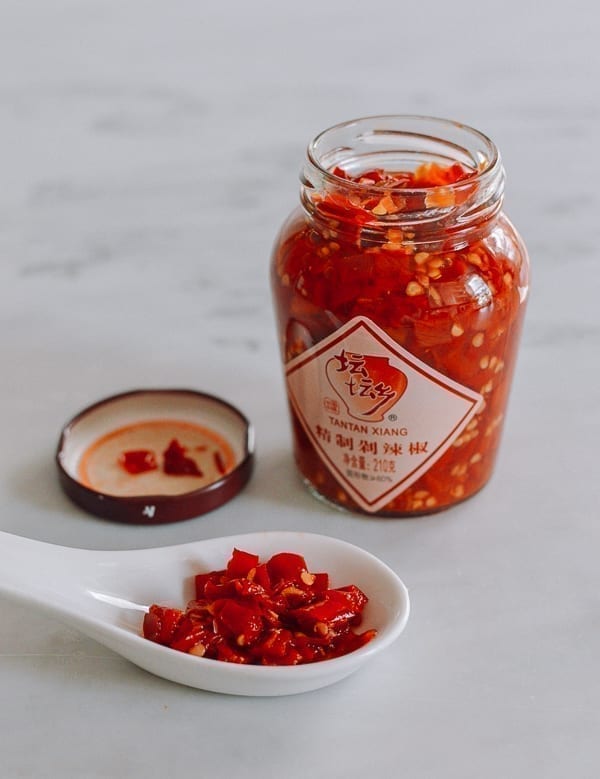
Duo Jiao (剁椒) literally translates to chopped (duò) chili pepper (jiāo). Chopped red chilis are pickled in a brine solution, and feature in several dishes from Hunan Province, where this sauce originated. Duo jiao has a salty and slightly pickled taste and is most commonly used in China for Hunan steamed fish head. We have a version of that uses filets, Hunan Steamed Fish with Salted Chilies and Tofu (Duo Jiao Yu) You can also make your own duo jiao at home!
Lao Gan Ma Chili Sauces (老干妈, Lǎo gàn mā)
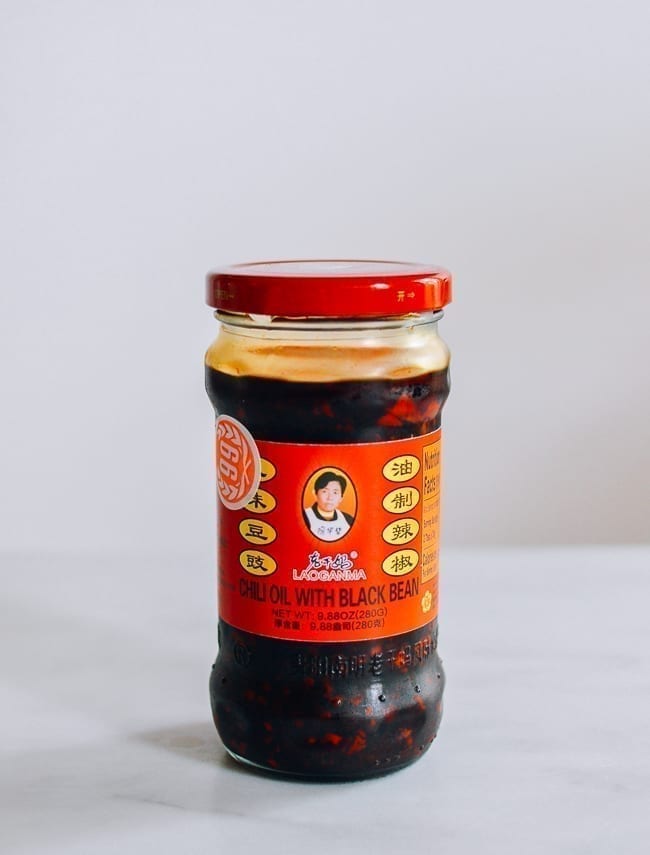
Lao Gan Ma, (老干妈) or “old godmother” is a brand of Chinese brand of chili sauce, famous for their Spicy Chili Crisp! Our favorite is Chili Oil with Black Bean, pictured left. We also have our own homemade version. These sauces are great all-purpose condiments for noodles, dumplings, or anything else you’d like to add a spicy kick to. If you’re looking for something more premium, try Fly By Jing Sichuan Chili Crisp, which is small batch crafted and preservative-free!
Chiu Chow Chili Sauce (潮州辣椒酱, Cháozhōu làjiāo jiàng)
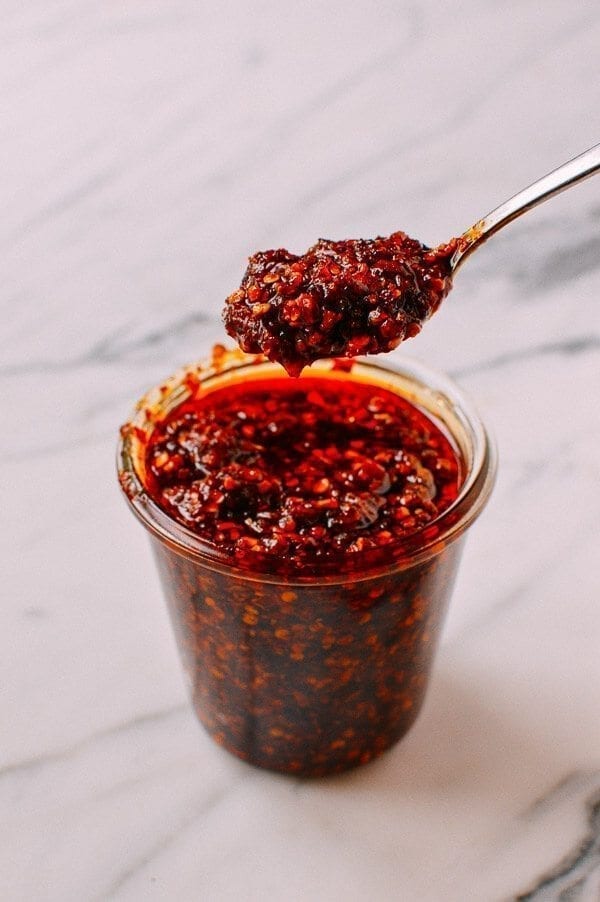
Chiu Chow Chili Oil, or Chiu Chow Chili Sauce, originates in Chaozhou, China (潮州). It is prepared with chilies and garlic blended with oil into a delightfully tasty spicy sauce that is quite addictive! We won’t pass any judgement if you decide to buy it (the brand we see most often is Lee Kum Kee Chiu Chow Chili Oil), but we do have a delicious homemade Chiu Chow Chili Oil recipe that is out of this world. Use it as a condiment for noodles, eggs, fried rice, dumplings, dim sum, and more!
Yellow Lantern Chili Sauce (黄灯笼辣椒酱, Huáng dēnglóng làjiāo jiàng)
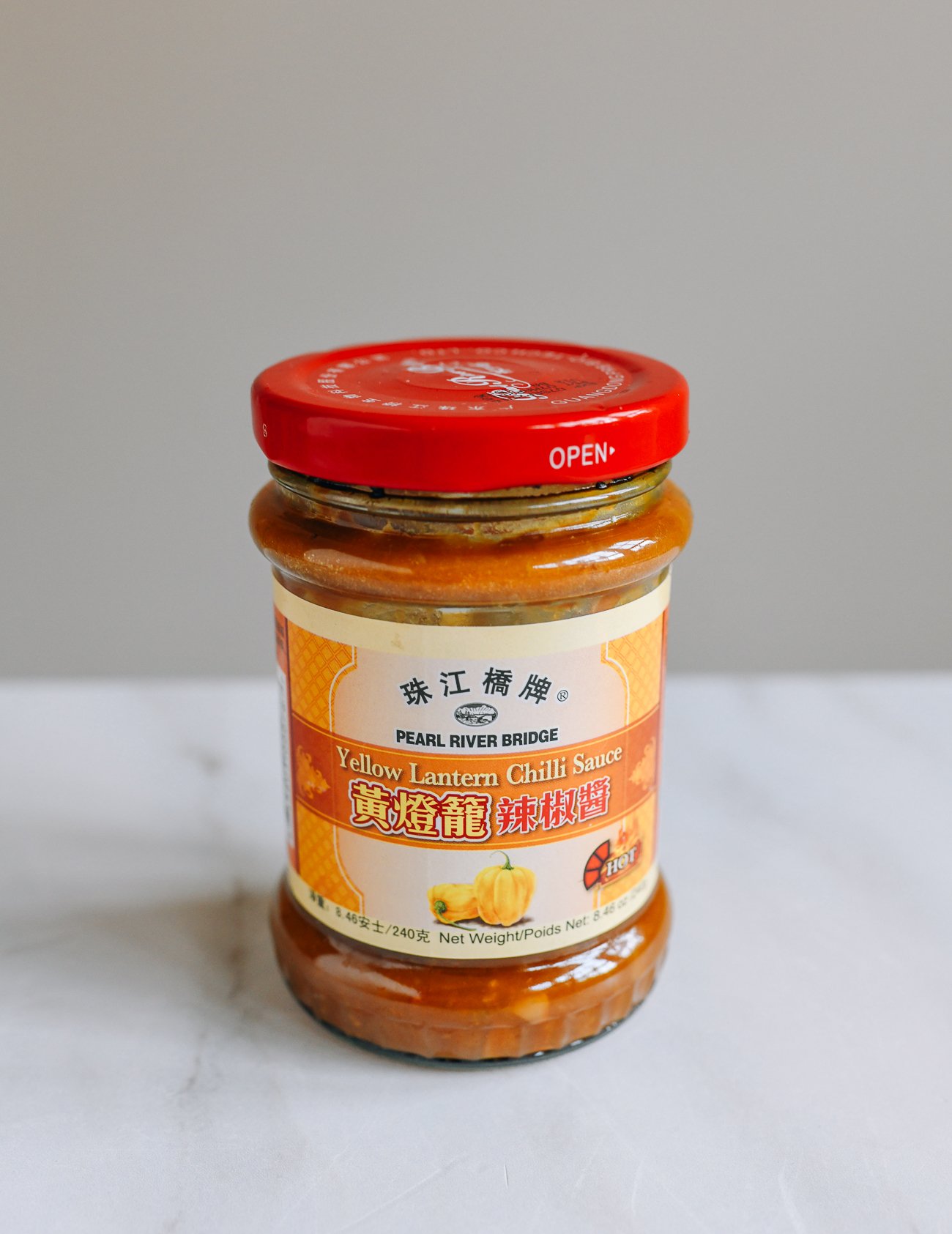
Yellow lantern chili sauce is made with fermented Hainan yellow lantern chilies, garlic, MSG, and pureed pumpkin, which adds heft to the sauce and balances the heat. Yellow lantern chilies are very hot, with a similar spice level to habaneros. This is a special ingredient for soups, stir-fries, noodles, or using as a dipping sauce. We don’t use it often, but there are a few specialty dishes that do call for it, which is why we’ve included it here! Find it online or in Chinese markets.
Sesame Paste (芝麻糊, zhī ma hú)
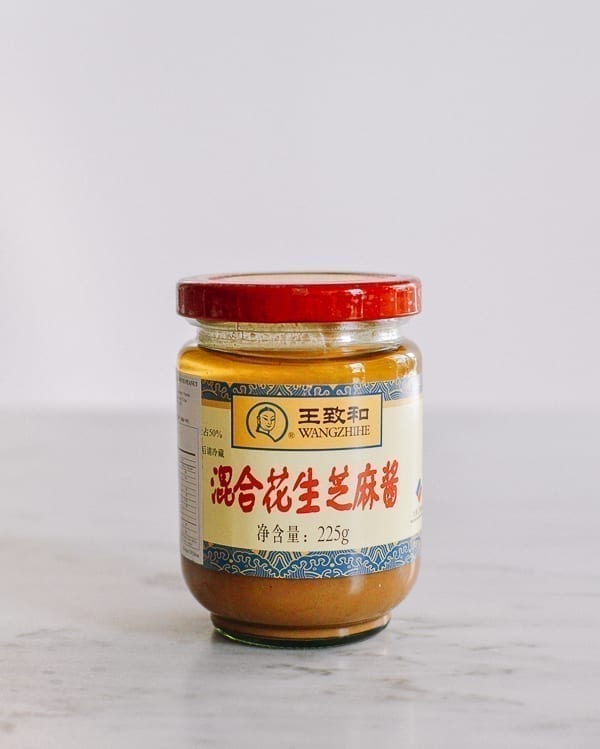
Chinese sesame paste is a richly flavored paste made from toasted sesame seeds (unlike tahini, which is a Middle Eastern raw sesame seed paste). If unavailable, peanut butter is a decent substitute for most applications. We use this ingredient for cold noodle dishes, and hot pot dipping sauces. Try our 10-Minute Sesame Noodles and hot dry noodles if you’d like to experiment with this ingredient!
Plum Sauce (苏梅酱, sū méi jiàng)
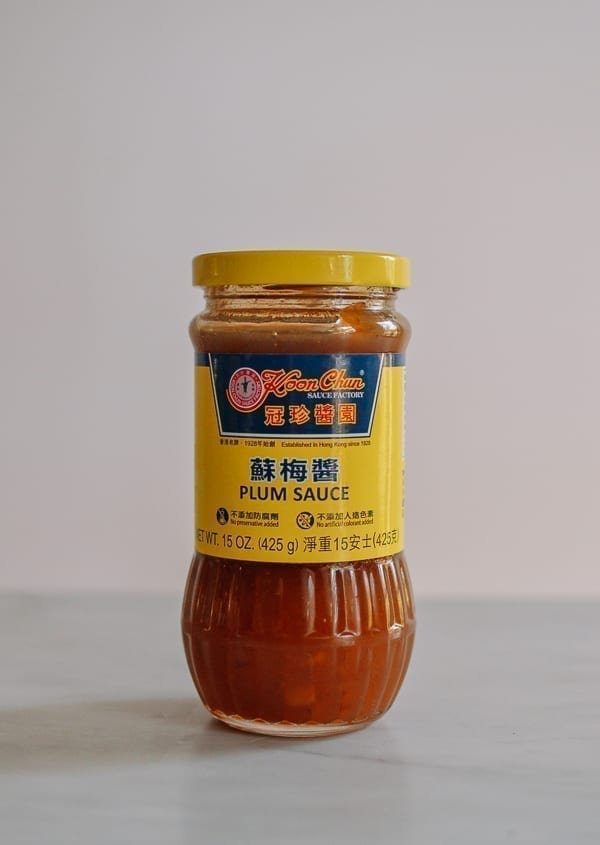
Plum Sauce is a slightly sour but mostly sweet sauce made from Chinese sour plums. Plum sauce is similar to the “duck sauce” you get in packets at your favorite Chinese take-out place, though it’s more tart and a bit less sugary. Plum sauces are used for dipping fried items like our Fried Wontons or Egg Rolls, but once in a while we use it for some special recipes like Sour Plum Roasted Duck. Koon Chun Plum Sauce is what we use, but there are other brands available, like Lee Kum Kee Plum Sauce.
Wines
Clear Rice Wine (米酒, Mǐjiǔ)
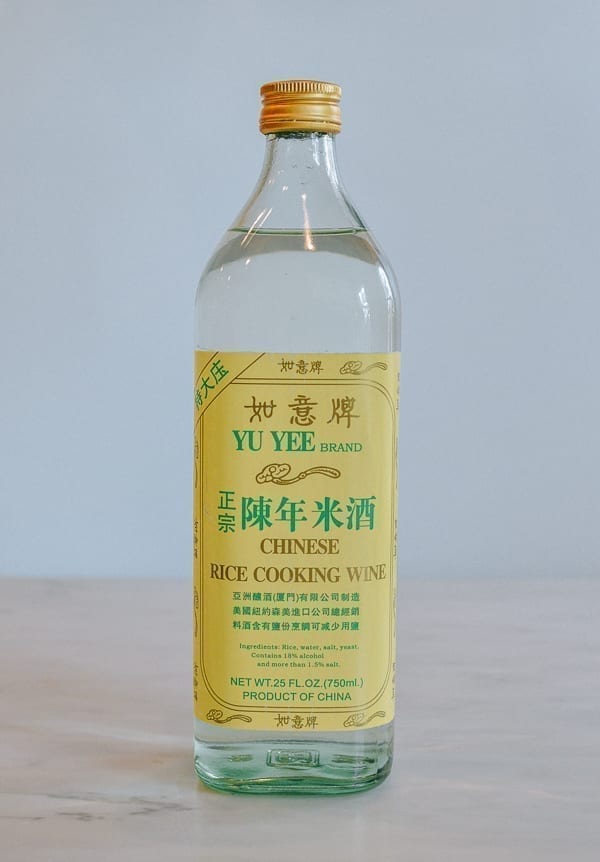
Chinese rice wine is used frequently in marinades, sauces, stir-fries, and more. While we use Shaoxing wine most often (a type of yellow wine or huángjiǔ – 黄酒, see below), we do sometimes use clear rice wine. It has a cleaner taste than yellow wine, making it ideal for use in fish and shellfish dishes as well as steamed recipes. You can also use it as a substitute for Shaoxing wine in a pinch. These Chinese cooking wines have salt added, and aren’t suitable for drinking. Find it in your local Chinese grocery store or online, sometimes labeled, “michiu.”
Shaoxing Wine (绍兴酒, Shàoxīngjiǔ)
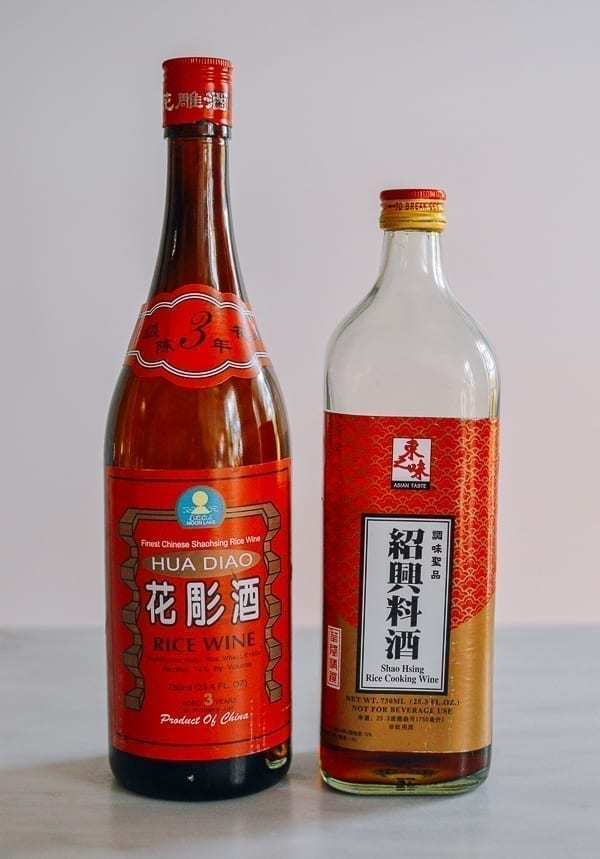
Shaoxing wine, or shàoxīng jiǔ (绍兴酒), is a type of Chinese yellow rice wine that hails from Shaoxing, a city in China’s Zhejiang Province famous for rice wine production. It’s a key ingredient in many dishes, and will create that authentic restaurant flavor you may have found difficult to replicate at home. We often buy bulk gallon jugs, as we use so much of it, but if you’d like something more high-quality, look for a 3-year-aged hua diao (also spelled hua tiao) wine like the bottle on the left.
Rose Wine (玫瑰露酒, Méiguī lùjiǔ)
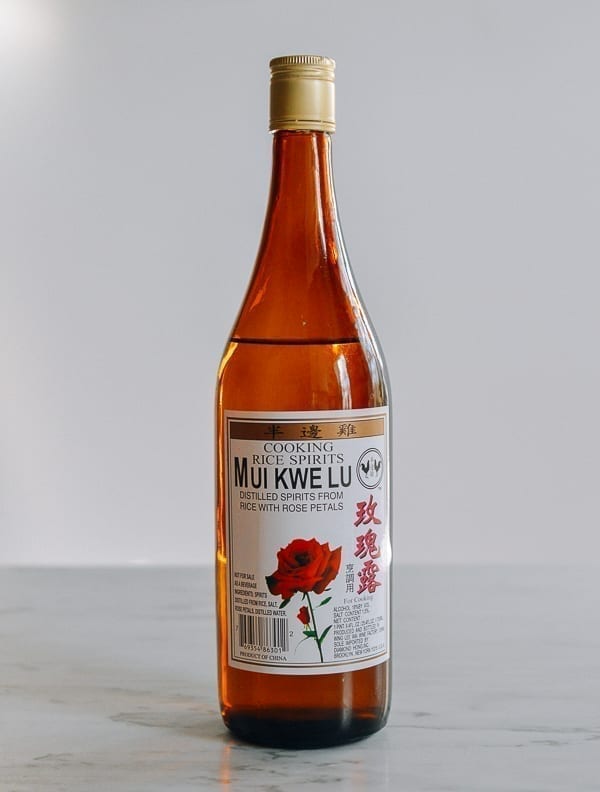
Chinese Rose Wine is a key ingredient in Cantonese roast meats and cured sausages. It’s a rose-flavored sorghum liquor infused with sugar and fresh rose flowers that some say tastes like a sweet, floral vodka. You can find versions made for cooking or drinking. (Versions for drinking are more like a spirit, with 50% alcohol, while the cooking version is 13-18% alcohol). We use this wine in our Soy Sauce Chicken recipe and for other braising liquids.
Bai Jiu (白酒, Báijiǔ)
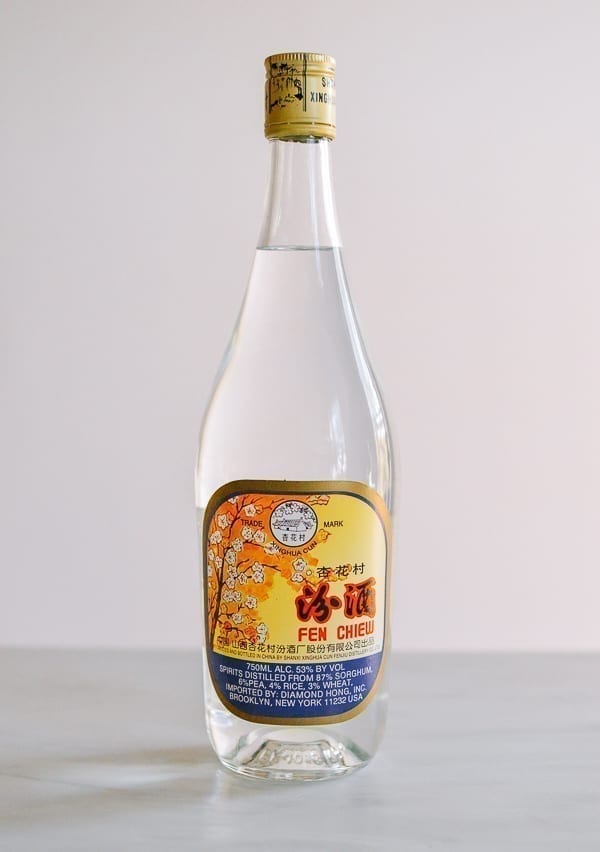
Bai Jiu (白酒) is a strong distilled spirit that is colorless, clear, and made from sorghum. It varies from 35 to 60% alcohol and has a very fragrant taste. Bai Jiu, literally translated as “white spirit” or what we call Chinese white lightning, is common in China and there are many types and varieties. Some brands made for drinking can be extremely expensive, though we purchase less expensive bottles for cooking. We use it for making cured meats like our Chinese Cured Pork Belly, as well as salted duck eggs.
Mirin
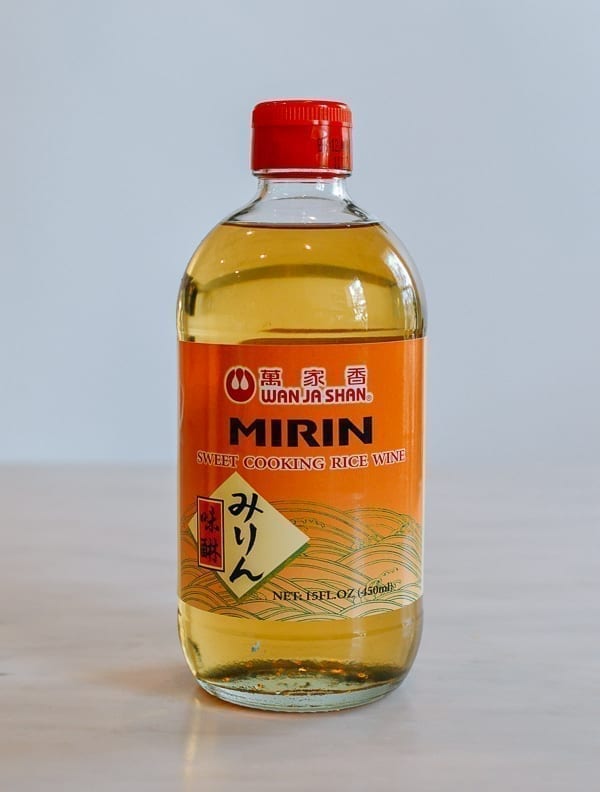
Mirin is a Japanese rice wine. It is much sweeter than sake. We don’t use Mirin in Chinese cooking, but we wouldn’t use anything else for teriyaki chicken. Use it in noodle and rice dishes, sauces, glazes, and broths. The most familiar use for it among Westerners is to make teriyaki sauce. It can be added to salad dressings, or mixed with dashi and soy sauce to make a dipping sauce for fried foods like tempura. There are different grades of mirin you can read about here.
Jiu Niang (酒酿, Jiǔniàng)
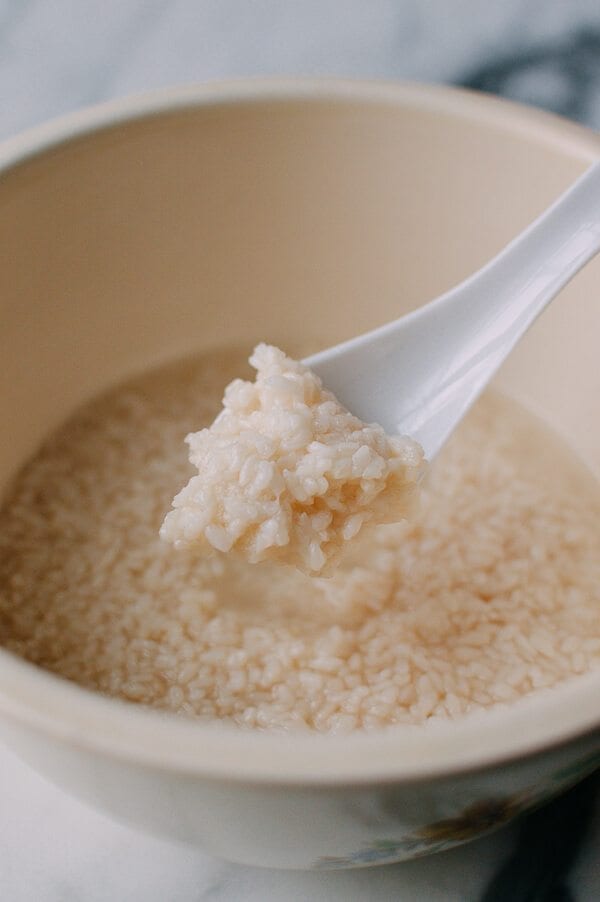
Jiu Niang (酒酿), or fermented sweet rice, is made with a yeast starter and sweet rice and has a low alcohol content of 1 to 2%. Jiu Niang is often served with Tang Yuan by simply placing a spoonful in the soup. It can also be used in savory dishes or baked goods. Jiu Niang is readily available at Chinese markets (usually in the refrigerated section), though you can also make it easily from scratch using our Jiu Niang recipe. You’ll need Chinese distiller’s yeast (see below) and glutinous rice, and about three days to allow it to ferment.
Jiu Qu – Distiller’s Yeast (酒曲, Jiǔqū)

Jiǔqū (酒曲), sometimes also referred to as jiǔ yào (酒藥) is a Chinese starter yeast or distiller’s yeast that comes in the form of solid dried white balls. It is commonly used in the production of Chinese alcoholic beverages and fermented foods, like sweet fermented rice. While it’s not a sauce or wine, it is used in the production of some wines and homemade jiu niang. Shop for jiuqu (酒曲) on Amazon.
Vinegars
Rice Vinegar (米醋, mǐcù)
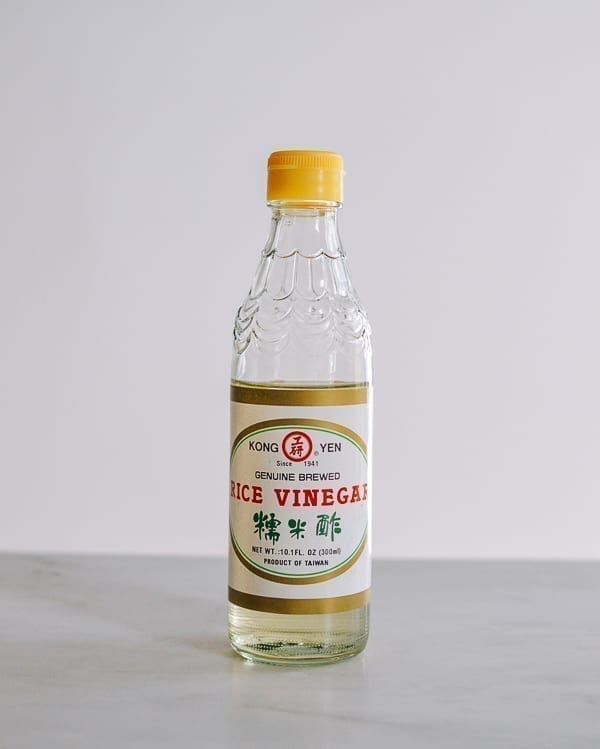
Rice vinegar, also known as rice wine vinegar, is made from fermented rice. It’s less acidic than Western distilled white vinegar and closest in flavor to cider vinegar, but slightly milder and without the fruity undertones. It can range from clear to golden in color. You may find seasoned versions, with added sugar and salt. Most brands are either Japanese, Chinese, or Taiwanese, and you can use any of these types. Rice vinegar is widely available, even in regular supermarkets.
Chinese black vinegar (镇江香醋, Zhènjiāng xiāng cù)
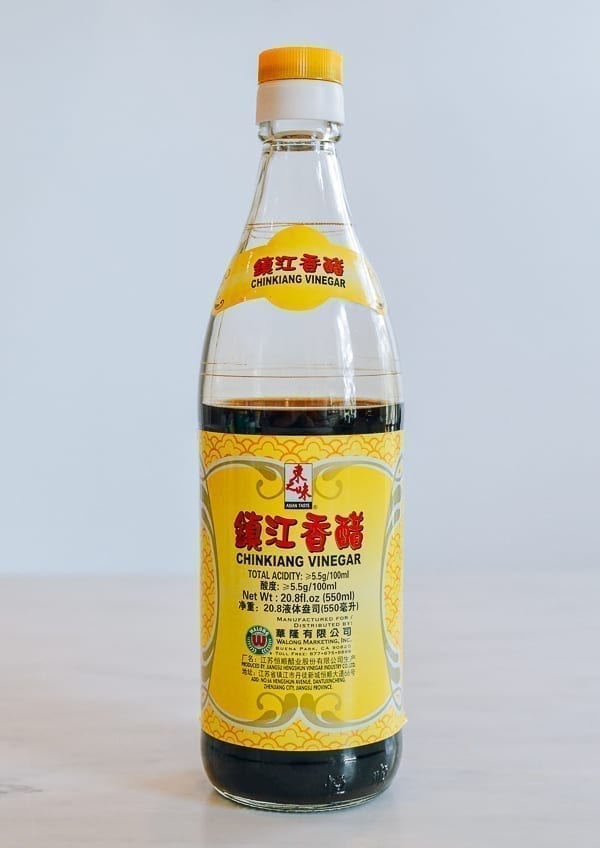
While there are different types of Chinese black vinegar, perhaps the most ubiquitous version comes from Zhenjiang (also sometimes spelled Chinkiang). It is more aromatic than regular rice vinegar, with a complex, malty taste and faint sweetness. Some of us could drink this stuff (lookin’ at you, Sarah!). We use it in dipping sauces, dressings, cold noodles, braised meat and fish dishes, and some stir-fries. Try it in our Chinese braised fish or as a dipping sauce for soup dumplings. Find it in any Chinese grocery store or online.
Chinese Red Vinegar (大红浙醋, Dàhóng zhè cù)
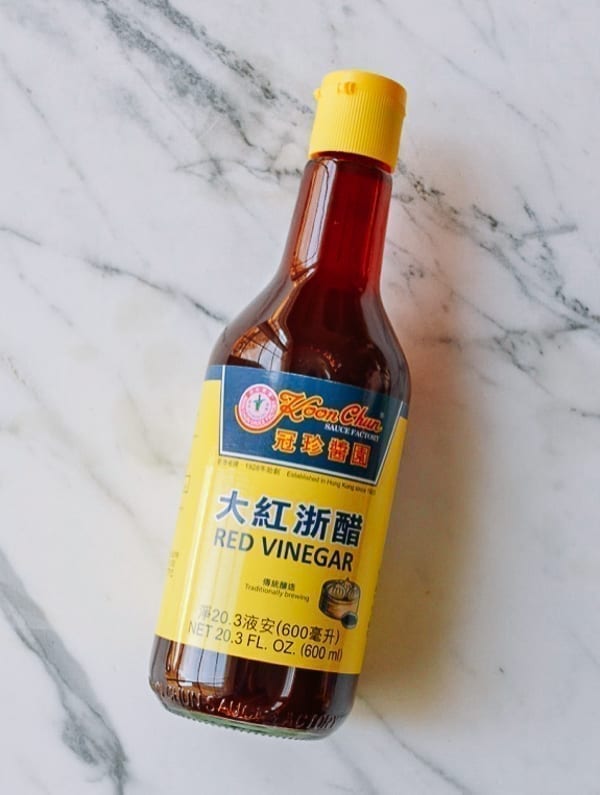
Red Rice Vinegar is mild with about half the acidity (2.47%) of your everyday white vinegar. It’s made from red yeast rice (which is a type of fermented rice made with red mold that gives this vinegar its color) and other grains like sorghum and barley. Koon Chun Red Vinegar has a distinctly winey taste with hints of sorghum. It is used to give Cantonese-style roast duck and fried squab that signature dark skin and is also served as a condiment for certain seafood soups.
Oils
Sesame oil (麻油, Máyóu)
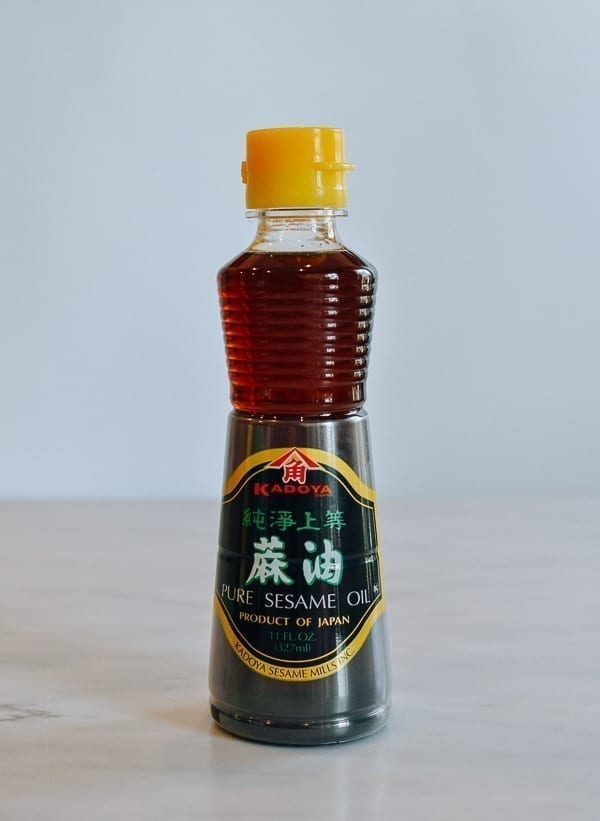
Sesame oil is a key seasoning across many East Asian cuisines, including Chinese cuisine. It has a powerful nutty flavor, and is usually added in small amounts towards the end of cooking. If we call for sesame oil, we mean toasted sesame oil; it should be as dark in color as the oil in the bottle pictured to the left (raw sesame oil, which is light yellow in color, doesn’t have the same flavor). You can find sesame oil in some mainstream grocery stores in the ethnic aisle, as well as any Asian grocery.
Red Chili Oil (红辣椒油, Hóng làjiāo yóu)
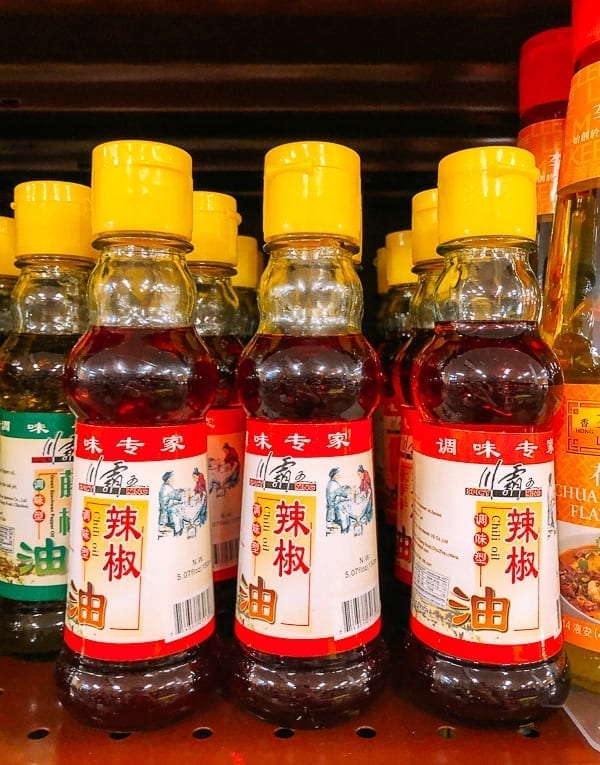
Red chili oil is a popular condiment for noodles, fried rice, dumplings, etc., but it can also be used in cooking—for dishes like mapo tofu and dan dan noodles. You may find it in the store as just pure oil, or with chili flakes at the bottom. We make our own chili oil regularly, and find it to be more fragrant and aromatic than store-bought versions. We infuse the oil with various spices, shallot, and garlic, and then pour the hot oil over Sichuan chili flakes. Many of our readers make it regularly!
Caiziyou – Rapeseed Oil (菜籽油, Cài zǐ yóu)
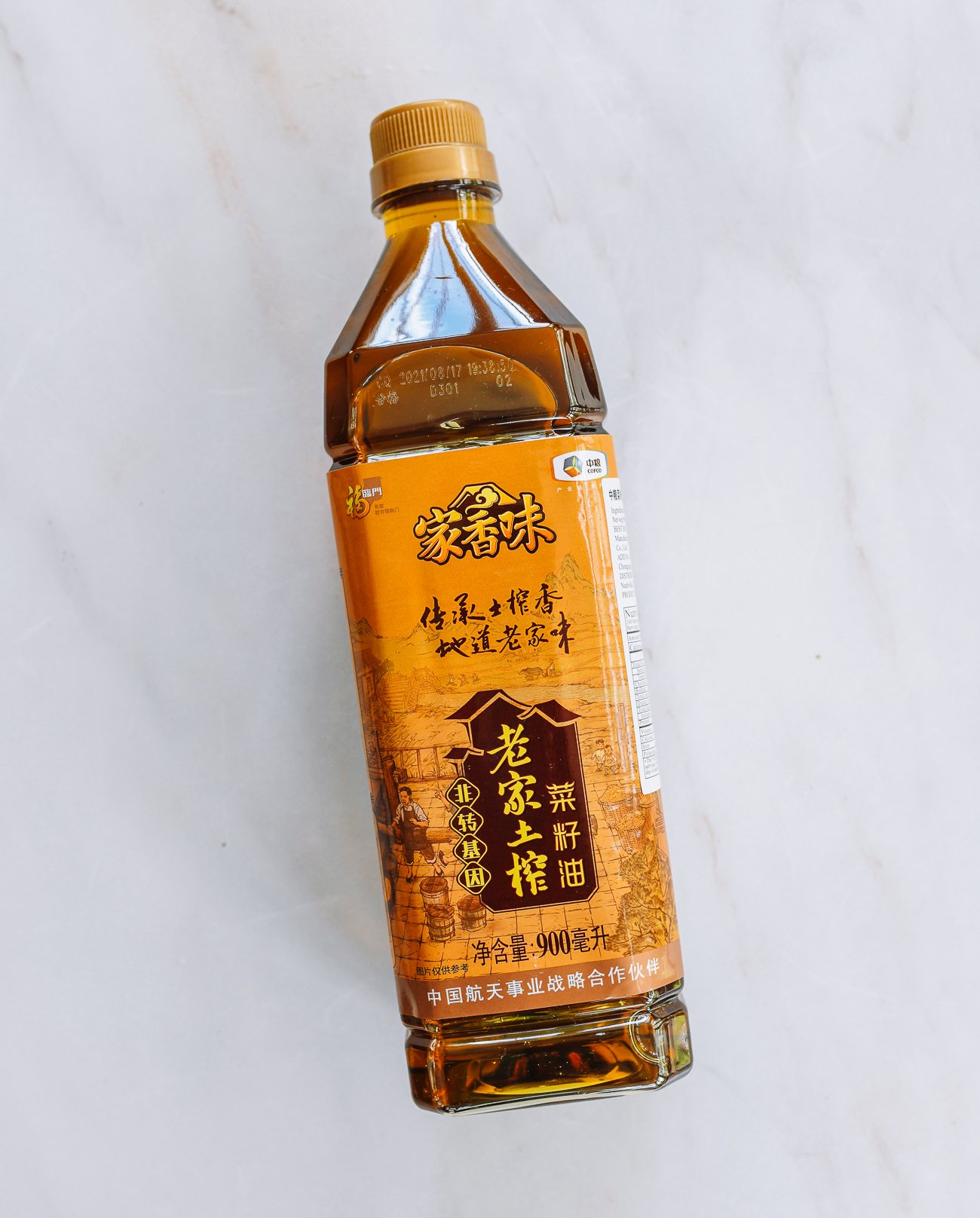
This is a popular cooking oil in Southwest China. It is made from roasted rapeseed, with a dark amber color and a nutty, vegetal flavor and aroma. You can use it for stir-frying, but it can be expensive if imported to the U.S. from China, so we reserve it for making chili oil, where that extra flavor can be savored (though you can use any neutral oil for chili oil generally). If you can’t find it at your local Chinese grocery, find it online at The Mala Market.
Sichuan Peppercorn Oil (花椒油, Huājiāo yóu)
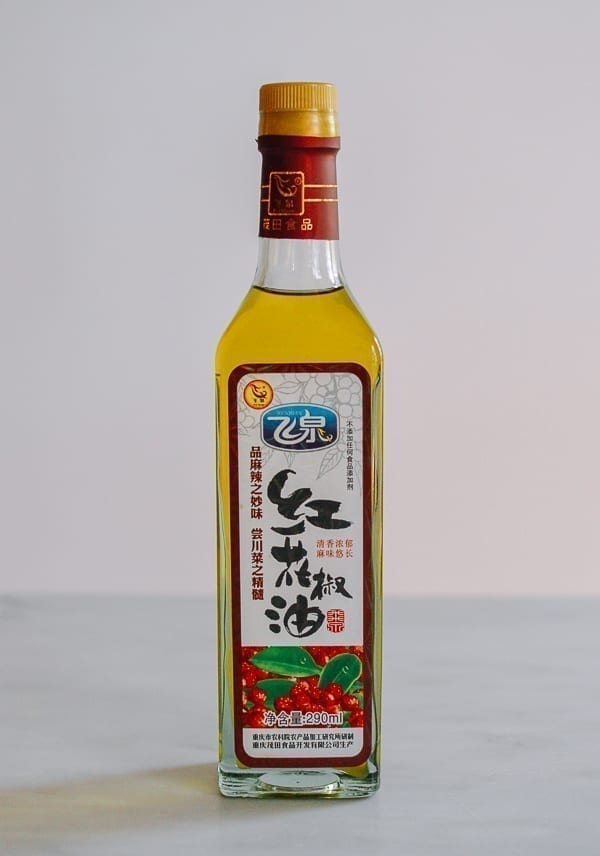
Sichuan peppercorn oil is a neutral oil infused with Sichuan peppercorns, a fragrant spice with a slightly floral, citrus-y taste and a numbing affect on the mouth! Along with chilies, Sichuan peppercorns create the distinctive mala (麻辣), or “numbing spicy” flavor of Sichuan cuisine. The oil can be made with green Sichuan peppercorns, or red Sichuan peppercorns. Generally, green Sichuan peppercorns are more floral and have a much stronger numbing effect than the red. Use sparingly as a finishing oil or in sauces.
Miscellaneous
Maltose (麦芽糖, mài yá táng)
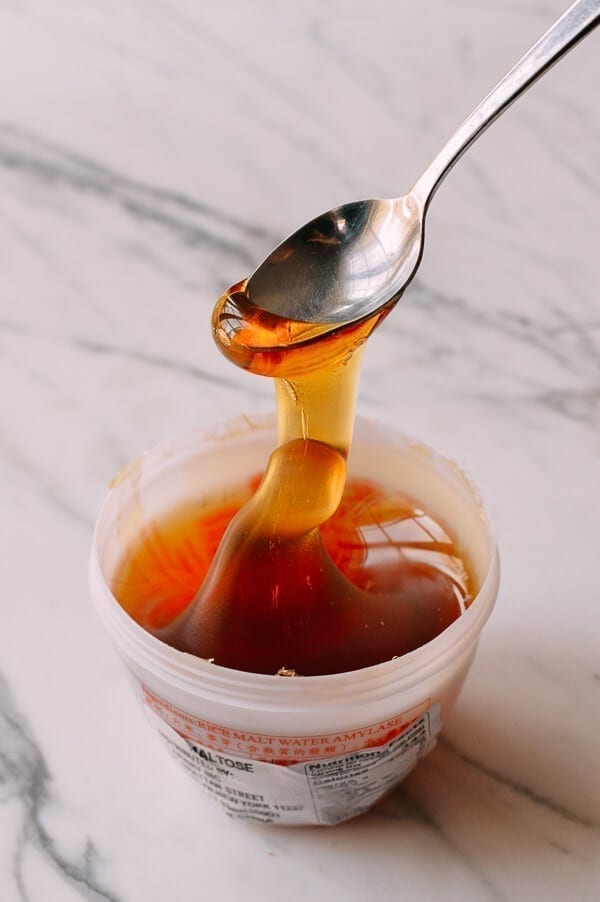
Maltose is a natural sweetener produced from fermented grains like barley and rice. It’s used in Chinese cooking for roasted meats and also for crisping up the skin on chickens, ducks and fried pigeon. Maltose can be difficult to work with, because it is quite dry and stiff compared to syrups and honey. It is not the easiest ingredient to measure, but becomes easier to spoon out of the container after heating it up in the microwave for 15 seconds. Try it in our Chinese roasted rib tips and Chinese BBQ Pork (Char Siu).
Fermented bean curd (腐乳, fú rú)
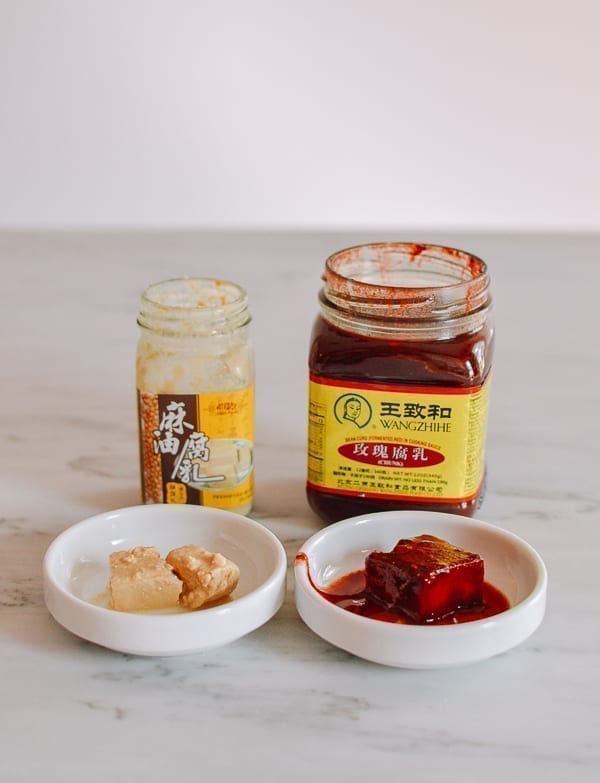
Fermented bean curd—also called fermented tofu, bean cheese, tofu cheese, or foo yee in Cantonese—is made by fermenting tofu with salt and rice wine. It does have a faintly cheesy flavor! While there are multiple types, the two most common are white fermented bean curd and red fermented bean curd. The white version can be eaten on its own with congee or used to cook stir-fried leafy greens. Red fermented bean curd is more often used in braises, sauces, and meat marinades.
Pickled Plum (苏梅子, Sū méizi)
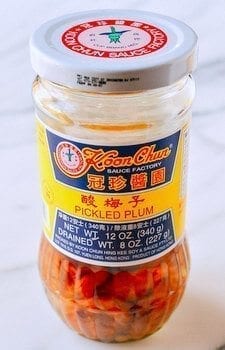
Pickled plums are sour, salted Chinese plums jarred in liquid. We use Koon Chun pickled plums. They’re different from umeboshi, or Japanese salted plums, though somewhat similar. In Chinese, pickled plums are called sū méi zi (苏梅子 in simplified characters and 蘇梅子 in traditional characters). Koon Chun is an old brand that still uses traditional Chinese characters in their labeling, which is why we’re including both forms of Chinese writing here. We use it in our Sour Plum Roasted Duck and our homemade duck sauce.
Tamarind Paste
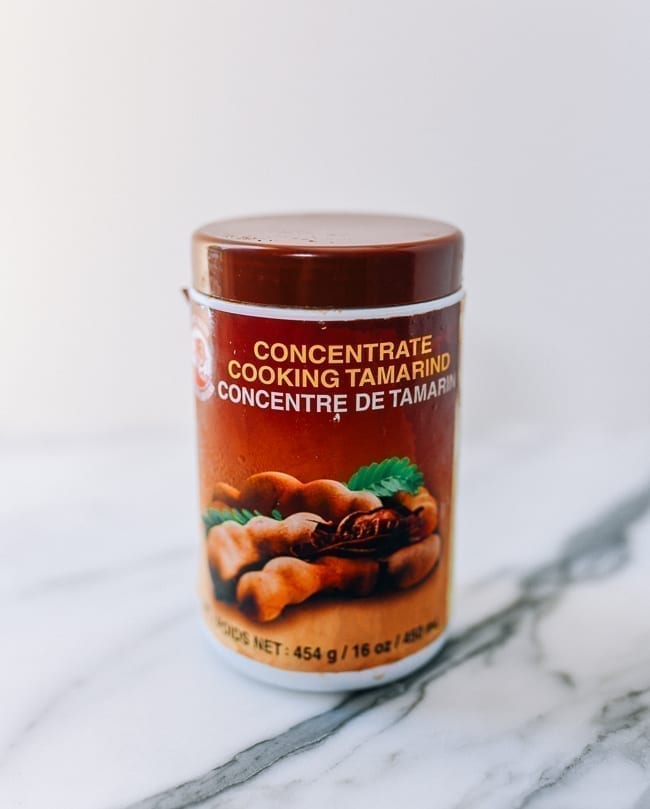
Tamarind is a tree native to Africa which produces brown pods that contain an edible pulp with a unique sour flavor. It is essential to making authentic pad thai, as well as other Thai and Southeast Asian dishes. Tamarind is also a key ingredient in India, Latin America, the Caribbean, and the Middle East. You can buy tamarind fresh, in dried blocks that need reconstituting in water, or as a paste/concentrate, which is the most convenient and widely available option.
Thai Curry Paste
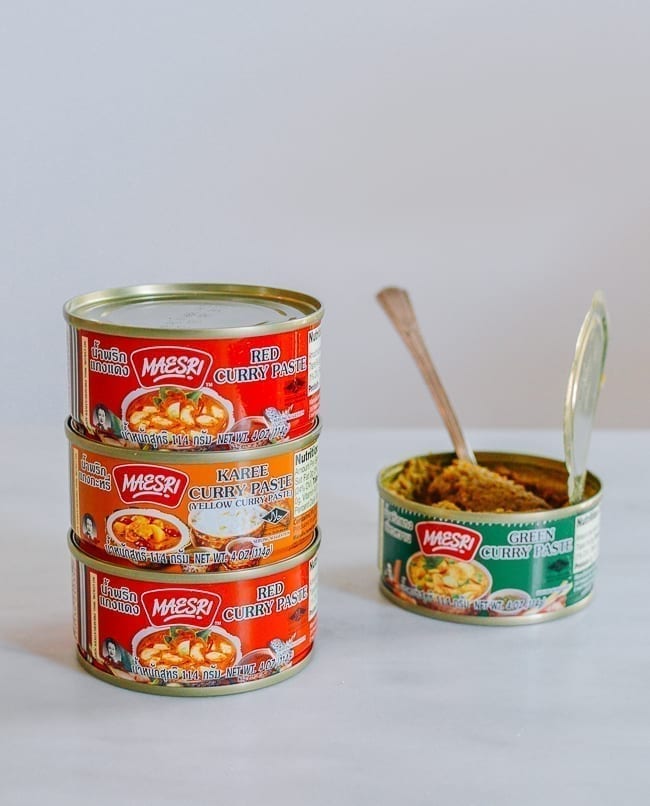
There are many Thai curry pastes available in Asian markets; they’re basically canned or jarred versions of curry pastes that might otherwise be made fresh. This allows you to whip up tasty Thai curries with minimal ingredients or prep work. The most common types are red curry paste and green curry paste. You may be able to find them in regular grocery stores these days, as well as online! For a basic recipe using one of these pastes, try our red curry chicken and green curry chicken.
Coconut Milk

Coconut milk is a key ingredient in various Southeast Asian cuisines. With the growing popularity of coconut products, it’s now pretty easy to find! You may see different options, like light coconut milk and coconut cream, each of which has a different fat content. We never buy light coconut milk, as it’s basically watered down (if you care about reducing the fat in your recipe, dilute regular coconut milk with water and freeze the remainder for later).
Gochujang
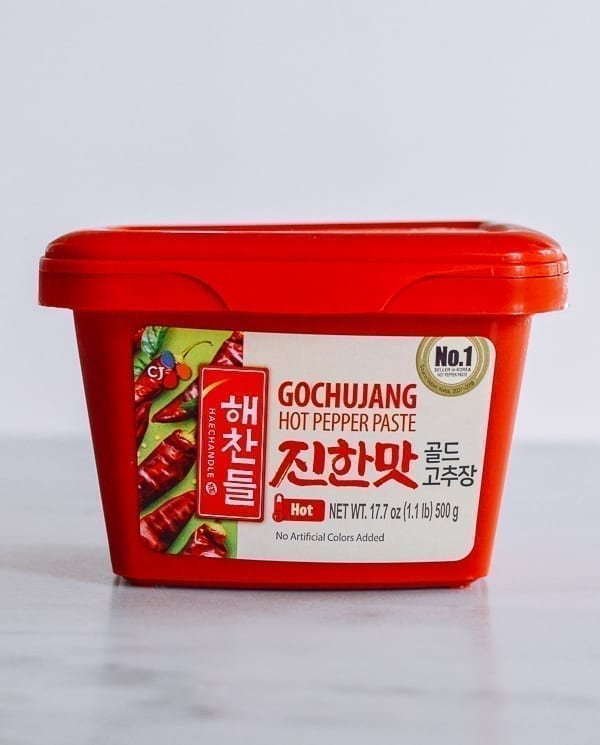
Gochujang is a savory, spicy, and pungent fermented Korean condiment made from red chili peppers, glutinous rice, fermented soybeans, and salt. Find it in Korean grocery stores like H-Mart and other well-stocked Asian markets. Gojuchang is used in many Korean dishes, and we do love Korean food! Check out our recipes for Beef Bibimbap, Kimchi Stew (Kimchi Jigae), and Crispy Pork Belly Kimchi Bowls, just to name a few!
Wasabi
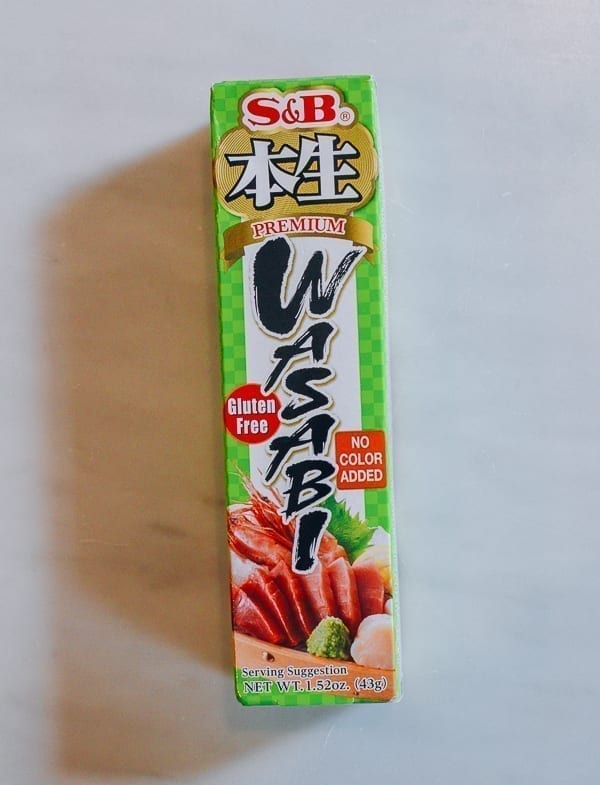
Everyone who’s tried sushi knows that wasabi, a light green spicy paste that tastes like horseradish, is served on the side with pickled ginger. Wasabi is a Japanese rhizome related to horseradish that grows naturally in mountain streams and rivers. It is extremely difficult to grow commercially, which is why any wasabi that comes in a tube (and most served in restaurants) isn’t wasabi at all, but horseradish! It will do for most applications, however; find it in your local Asian market.
Hot pot soup base (火锅底料, HUǑGUŌ DǏ LIÀO)
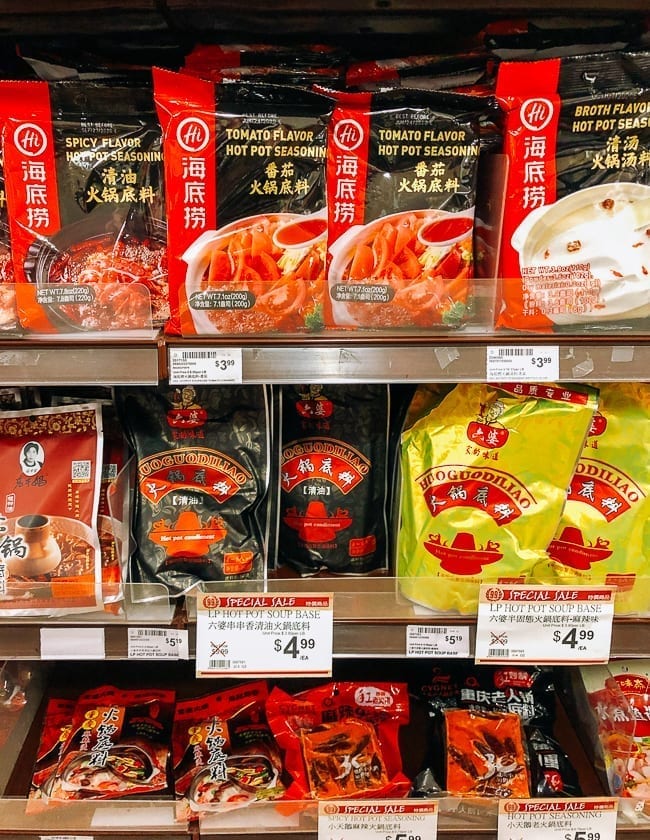
Hot Pot (huǒguō, 火锅) is a type of Chinese meal involving a simmering pot of broth and various raw ingredients. Hot pot soup bases are pre-packaged seasonings meant to be added to water to make preparing a hot pot meal at home easier. They come in small packets of different varieties––soup bases for Mongolian Hot Pot, Seafood Hot Pot, Spicy Sichuan Hot Pot, etc. and can be quite complex in flavor. A well-stocked Chinese market will have many varieties!
Potassium Carbonate (碱水, jiǎn shuǐ)
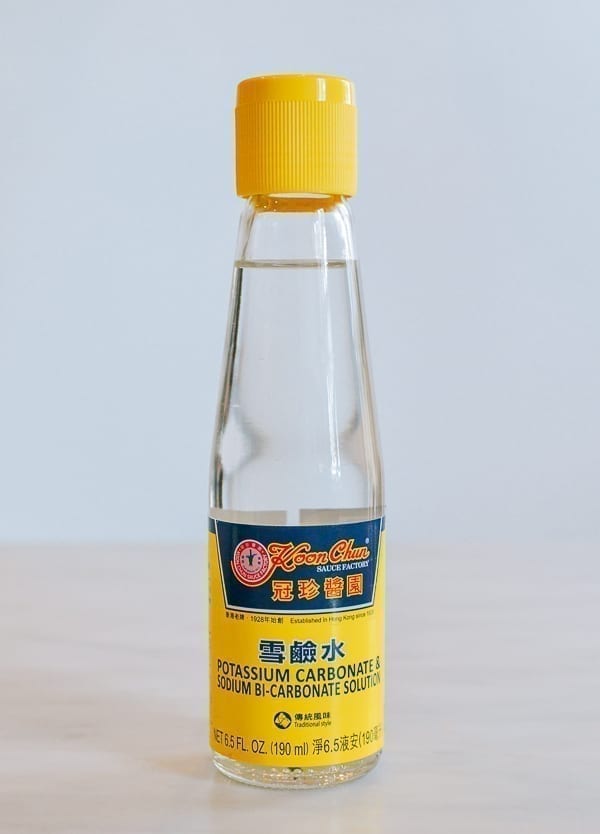
A potassium carbonate solution, also known as lye water, is an alkaline ingredient used to make various types of noodles, dough, and alkaline rice dumplings, or jianshui zongzi. Other recipes using it include Chinese fried dough (yóu tiáo) and mooncakes. You can find this solution in well-stocked Chinese grocery stores and online.